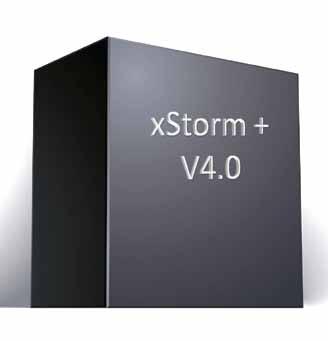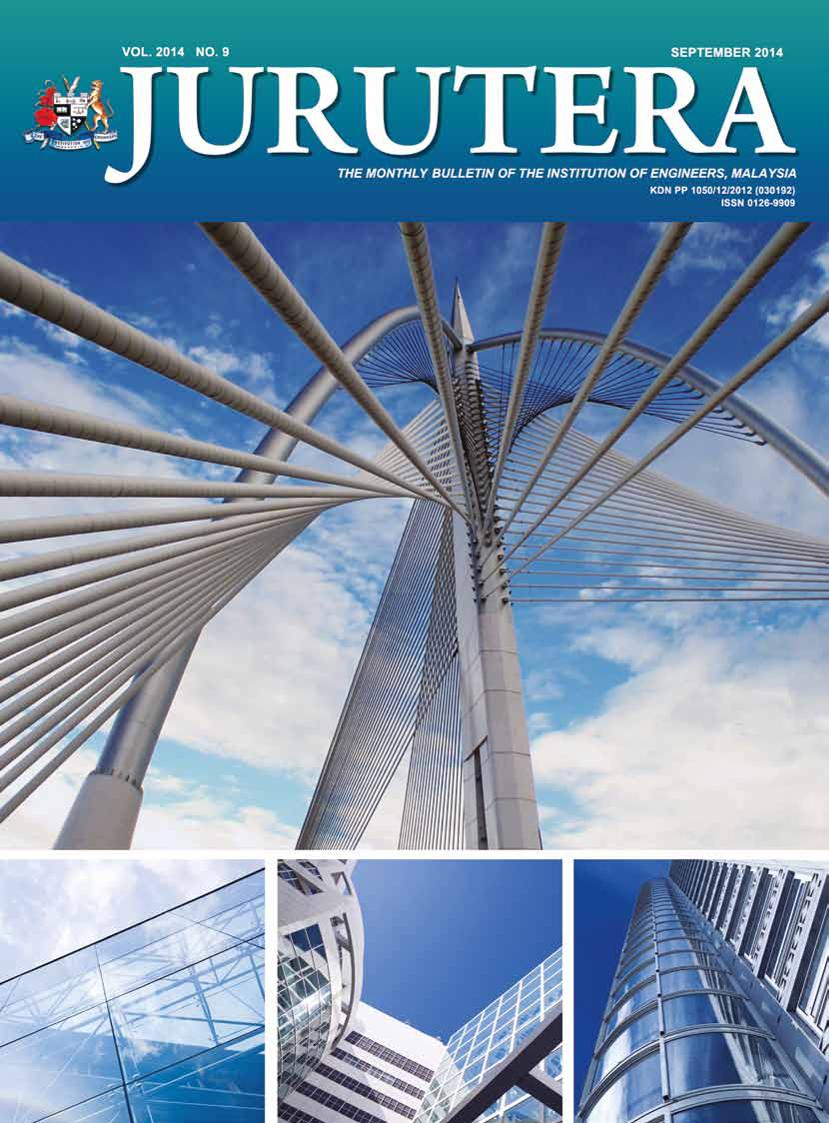

Implementation of in Malaysia Structural Eurocodes
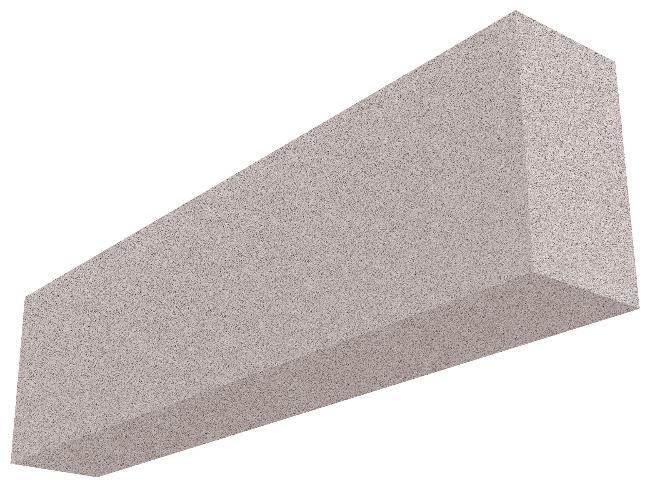
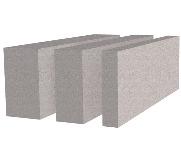
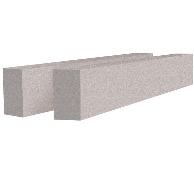
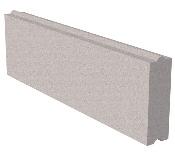
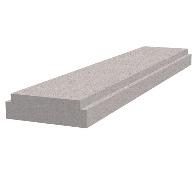
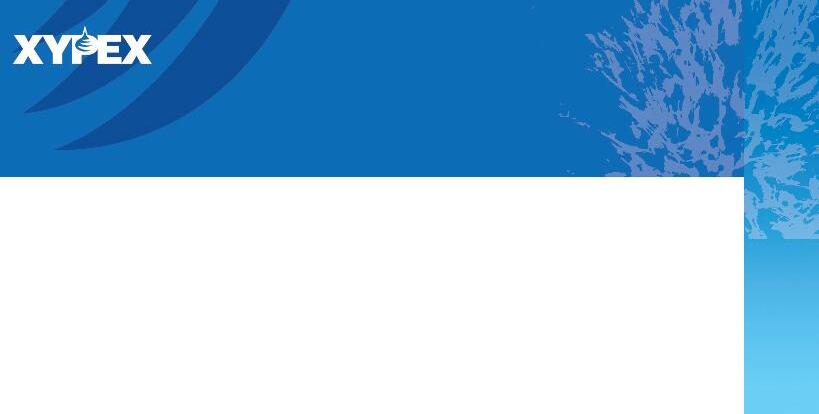
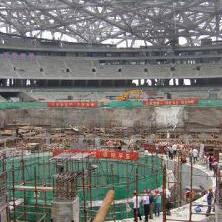
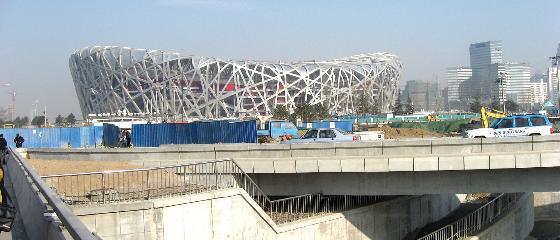
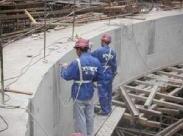
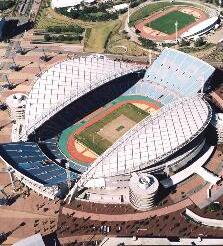

No. 37, Jalan Putra Mahkota 7/7B
Putra Heights, 47650 Subang Jaya

JURUTEA
Number 9, September 2014
yaNg DIpERtua / pRESIDENt
Y.Bhg. Dato’ Ir. Lim Chow Hock
tIMbalaN yaNg DIpERtua / DEputy pRESIDENt
Ir. Tan Yean Chin
NaIb yaNg DIpERtua / VIcE pRESIDENtS
IEM Registered on 1 May 1959
Ir. P.E. Chong, Ir. Prof. Dr Wan Mahmood bin Wan Ab. Majid, Ir. Prof. Dr Lee Teang Shui, Ir. David Lai Kong Phooi, Y.Bhg. Dato Ir. Dr Andy Seo Kian Haw, Ir. Lee Weng Onn, Ir. Gopal Narian Kuty
SEtIauSaha KEhoRMat / hoNoRaRy SEcREtaRy Ir. Gunasagaran a/l Kristnan
bENDahaRI KEhoRMat / hoNoRaRy tREaSuRER
Ir. Prof. Dr Jefrey Chiang Choong Luin
bEKaS yaNg DIpERtua tERaKhIR / IMMEDIatE paSt pRESIDENt
Ir. Choo Kok Beng
bEKaS yaNg DIpERtua / paSt pRESIDENtS
Y.Bhg. Dato’ Ir. Pang Leong Hoon, Y.Bhg. Academician Tan Sri Dato’ Ir. (Dr) Hj. Ahmad Zaidee bin Laidin, Y.Bhg. Dato’ Ir. Dr Gue See Sew, Y.Bhg. Datuk Ir. Prof. Dr Ow Chee Sheng, Y.Bhg. Academician Dato’ Ir. Prof. Dr Chuah Hean Teik
WaKIl aWaM / cIVIl REpRESENtatIVE
Ir. Prof. Dr Mohd. Zamin bin Jumaat
WaKIl MEKaNIKal / MEchaNIcal REpRESENtatIVE
Ir. Dr Kannan M. Munisamy
WaKIl ElEKtRIK / ElEctRIcal REpRESENtatIVE
Ir. Ali Askar bin Sher Mohamad
WaKIl StRuKtuR / StRuctuRal REpRESENtatIVE
Ir. Hooi Wing Chuen
WaKIl KIMIa / chEMIcal REpRESENtatIVE
Ir. Prof. Dr Abdul Aziz bin Abdul Raman
WAkIL LAIN-LAIN DISPLIN / REPRESENTATIVE TO OTHER DISCIPLINES
Ir. S. Kumar a/l Subramaniam
WaKIl MultIMEDIa / MultIMEDIa REpRESENtatIVE
Engr. Abdul Fatah bin Mohd. Yaim, M.I.E.M.
ahlI MajlIS / couNcIl MEMbERS
Ir. Lee Boon Chong, Ir. Tu Yong Eng, Ir. Lai Sze Ching, Ir. Yap Soon Hoe, Ir. Li Thang Fai, Ir. Juares Rizal bin Abd. Hamid, Ir. Norazman bin Mohamad Nor, Ir. Ellias bin Saidin, Ir. Assoc. Prof. Dr Jimmy Mok Vee Hoong, Ir. Dr Tan Chee Fai, Ir. Kok Hee Poh, Ir. Tiong Ngo Pu, Ir. Yau Chau Fong, Ir. Teh Piaw Ngi, Ir. Assoc. Prof. Ahmad Kamil bin Arshad, Ir. Kim Kek Seong, Ir. Chong Chin Meow, Ir. Chin Kuan Hwa, Ir. Assoc. Prof. Dr Vigna Kumaran Ramachandaramurthy, Ir. Lee Cheng Pay, Ir. Ong Ching Loon, Ir. Gary Lim Eng Hwa, Y.Bhg. Dato’ Ir. Noor Azmi bin Jaafar, Ir. Aminuddin bin Mohd. Baki, Ir. Mohd. Radzi bin Salleh, Ir. Ong Sang Woh
pENgERuSI caWaNgaN / bRaNch chaIRMaN
1. Pulau Pinang: Ir. Paul Phor Chi Wei
2. Selatan: Ir. Assoc. Prof. Hayai bini Abdullah
3. Perak: Ir. Dr Perumal Nallagownden
4. Kedah-Perlis: Ir. Chua Teik Seng
5. Negeri Sembilan: Ir. Shahrin Amri bin Jahari
6. Kelantan: Ir. Hj. Syed Abdul Rahman bin Syed Abdullah
7. Terengganu: Ir. Hj. Abdullah Zawawi bin Mohd. Nor
8. Melaka: Ir. Nur Fazil Noor Mohamed
9. Sarawak: Ir. Haidel Heli
10. Sabah: Ir. Tan Koh Yon
11. Miri: Ir. Steven Chin Hui Seng
12. Pahang: Ir. Tuan Haji Ahmad Kamal bin Kunji
ahlI jaWataNKuaSa INfoRMaSI DaN pENERbItaN / StaNDINg coMMIttEE oN INfoRMatIoN aND publIcatIoNS 2014/2015
Pengerusi/Chairman: Ir. Prof. Dr Lee Teang Shui
Naib Pengerusi/Vice Chairman: Ir. Dr Tan Chee Fai Seiausaha/Secretary: Ir. Lau Tai Onn
Ketua Pengarang/Chief Editor: Ir. Prof. Dr Lee Teang Shui Pengarang Bulein/Bullein Editor: Ir. Mohd. Khir Muhammad Pengarang Prinsipal Jurnal/Principal Journal Editor: Ir. Prof. Dr Dominic Foo Chwan Yee
Pengerusi Perpustakaan/Library Chairman: Ir. C.M.M. Aboobucker
Ahli-Ahli/Commitee Members: Y.Bhg. Datuk Ir. Prof. Dr Ow Chee Sheng, Engr. Abdul Fatah bin Mohamed Yaim, M.I.E.M., Ir. Dr Kannan a/l M. Munisamy, Ir. Siow Yun Tong, Ir. Chin Mee Poon, Ir. Yee Thien Seng, Ir. Tu Yong Eng, Ir. Ong Guan Hock, Engr. Aida Yazrin Mohd. Khairi, Engr. Kok Jing Shun
lEMbaga pENgaRaNg/EDItoRIal boaRD 2014/2015
Ketua Pengarang/Chief Editor: Ir. Prof. Dr Lee Teang Shui
Pengarang Bulein/Bullein Editor: Ir. Mohd. Khir Muhammad Pengarang Jurnal/Journal Editor: Ir. Prof. Dr Dominic Foo Chwan Yee Ahli-ahli/Commitee Members: Ir. Ong Guan Hock, Ir. Lau Tai Onn, Ir. Yee Thien Seng
(IEM Secretariat: Pamela Jitab, May Lee)
thE INStItutIoN of ENgINEERS, MalaySIa
Bangunan Ingenieur, Lots 60 & 62, Jalan 52/4, P.O. Box 223, (Jalan Sultan), 46720 Petaling Jaya, Selangor Darul Ehsan. Tel: 603-7968 4001/4002 Fax: 603-7957 7678
E-mail: sec@iem.org.my Homepage: htp://www.myiem.org.my
conTEnTs

COVER NOTE
“Implementation of Structural Eurocodes in Malaysia”............................5
COVER sTORy
Towards the Implementation of Structural Eurocodes in Malaysia..........6 fEaTuRE aRTiClEs
ImplicationsandTimelinetoImplementEurocodesinMalaysia.............11 Realibility Analysis for Concrete Structures...........................................16 Eurocode 3: Design of Steel Structures BS EN 1993-1-8: 2005 Design of Joints Journey of The Malaysian Annexe................22 Effects of Thunderstorm Winds in Determining Suitable Wind Speeds for Design of Building Structures in Peninsular Malaysia and Actions...26 Preview of National Annex to EC8: Seismic Loadings for Peninsular Malaysia, Sabah and Sarawak..........................................................32
Half-day Seminar on “Impact of Structural Eurocodes on Steel and Composite Steel-Concrete Structures...............................................36
Two-Day Course on Simpliied-Uniied Practical Design to MS ECO, MS EC1 and MS EC2 from A Consulting Engineer’s Perspective....37 2-Day Workshop on “Recommended Earthquake Loading Model in The Proposed National Annex (N.A.) to EC8 for Sabah, Sarawak and Update for Peninsular Malaysia”....................
IEM DIARY oF EVEnTs
One Day Symposium on Protecion Against Lightning
27th November 2014
Organisedby :ElectricalEngineeringTechnicalDivision Time :9.00a.m.–5.00p.m. Venue :GrandDorset,Subang,Malaysia CPD/PDP: :6.0
Kindly note that the scheduled events below are subject to change. Please visit the IEM website at www.myiem.org.my for more informaion on the upcoming events.
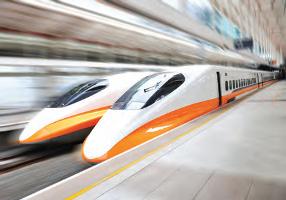

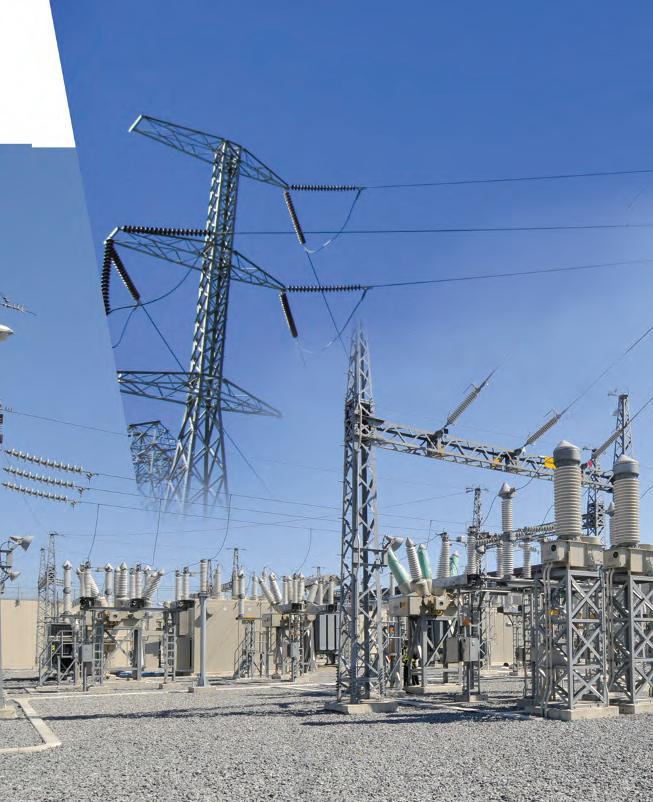
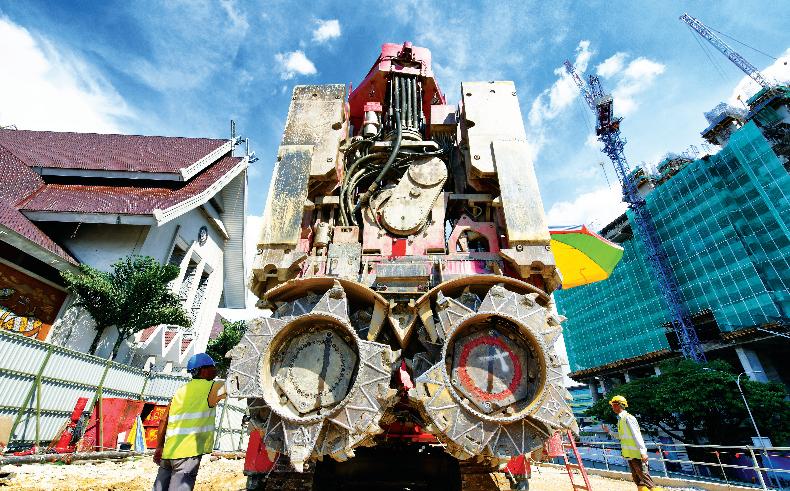
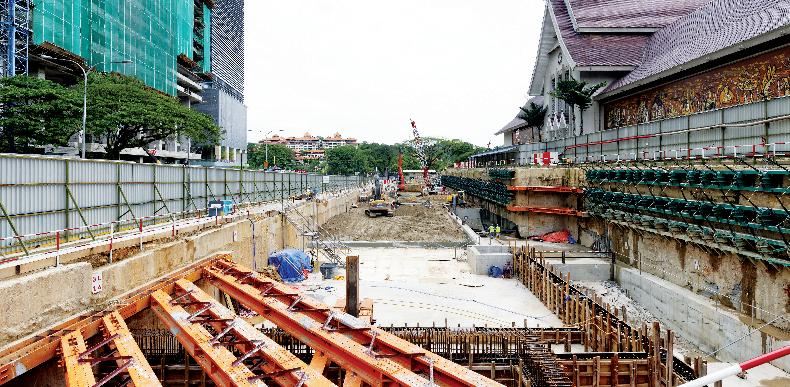
gTHE WORLD LEADER IN GROUND TECHNOLOGIES As a world benchmark in foundations and soil technologies, Bachy Soletanche delivers a comprehensive range of geotechnical processes, tunneling and underground works. Building on its track record, Bachy Soletanche brings its integrated skills to the development of major Mass Railway Transit – MRT
BACHY SOLETANCHE
BSG Construction (Malaysia) Sdn Bhd
C1-3-1, Solaris Dutamas - 1, Jalan Dutamas 1 - 50480 Kuala Lumpur - Malaysia
Tel: +(60)3-6205 3693 - Fax: +(60)3-6205 3108
Email: malaysia@soletanche-bachy.com
DIMEnsIon pUblIshIng sDn. bhD. (449732-T)
Level 18-01-03, PJX-HM Shah Tower, No. 16A, Persiaran Barat, 46050 Petaling Jaya, Selangor Darul Ehsan, Malaysia. Tel: +(603) 7493 1049 Fax: +(603) 7493 1047 E-mail: info@dimensionpublishing.com Website: www.dimensionpublishing.com
Chairman ROBERT MEBRUER
CEO/Publisher PATRICK LEUNG
General Manager SHIRLEY THAM shirley@dimensionpublishing.com
Business Development Manager JOSEPH HOW joseph@dimensionpublishing.com
Editor TAN BEE HONG bee@dimensionpublishing.com
Writer ARMAN PFORDTEN pfordten@dimensionpublishing.com
Senior Graphic Designer SUMATHI MANOKARAN sumathi@dimensionpublishing.com
Graphic Designer NABEELA AHMAD beela@dimensionpublishing.com
Senior Adverising Consultant ROSELIZA ABDULLAH roseliza@dimensionpublishing.com
Accounts cum Admin Execuive YONG YEN YIN yenyin@dimensionpublishing.com
For adverisement placements and subscripions, please contact: DIMENSIoN publIShINg SDN. bhD. (449732-T) at +(603) 7493 1049, or E-mail: info@dimensionpublishing.com
Subscripion Department
E-mail: subscripion@dimensionpublishing.com
Printed by hoffSEt pRINtINg SDN. bhD. (667106-V) No. 1, Jalan TPK 1/6, Taman Perindustrian Kinrara, 47180 Puchong, Selangor Darul Ehsan, Malaysia. Tel: +(603) 8075 7222 Fax: +(603) 8075 7333
Mailer
pERfEct MaIl SERVIcES (648839-P) 14 Jalan TSB 2, Taman Perindustrian Sungai Buloh, Sungai Buloh, Selangor Darul Ehsan, Malaysia. Tel: +(603) 6156 5288
juRutERa MoNthly cIRculatIoN: 30,000 copIES
Submission or placement of aricles in JURUTERA could be made to the:Chief Editor THE INSTITUTION OF ENGINEERS, MALAYSIA (IEM) Bangunan Ingenieur, Lots 60 & 62, Jalan 52/4, P.O. Box 223 (Jalan Sultan), 46720 Petaling Jaya, Selangor. Tel: +(603) 7968 4001/4002 Fax: +(603) 7957 7678 E-mail: pub@iem.org.my or sec@iem.org.my IEM Website: htp://www.myiem.org.my © 2014, The Insituion of Engineers, Malaysia (IEM) and Dimension Publishing Sdn. Bhd.
publIcatIoN DISclaIMER
The publicaion has been compiled by both IEM and Dimension with great care and they disclaim any duty to invesigate any products, process, services, designs and the like which may be described in this publicaion. The appearance of any informaion in this publicaion does not necessarily consitute endorsement by IEM and Dimension. There is no guarantee that the informaion in this publicaion is free from errors. IEM and Dimension do not necessarily agree with the statement or the opinion expresssed in this publicaion.
copyRIght
JURUTERA Bullein of IEM is the oicial magazine of The Insituion of Engineers, Malaysia (IEM) and is published by Dimension Publishing Sdn. Bhd. The Insituion and the Publisher retain the copyright over all materials published in the magazine. No part of this magazine may be reproduced and transmited in any form or stored in any retrieval system of any nature without the prior writen permission of IEM and the Publisher.

“Implementation
of structural Eurocodes in Malaysia”
by Ir. Hooi Wing Chuen Chairman, Civil and Structural Technical Division, IEM
cIVIl & Structural Engineering is possibly the oldest form of engineering known to man. Over thousands of years it has evolved in tandem with the needs of its communiies. However, standards of development of communiies around the world are naturally quite diferent, making growth across borders diicult.
On the other hand thanks to a common standards plaform, the inancial, informaion and communicaion technology industries have become virtually borderless today. Similarly, the Civil & Structural Engineering industry should pursue a set of standards common to most if not all global communiies. When the Briish Standards Insituion announced its plans to withdraw the Briish Standards, the IEM C&STD took the opportunity to survey and study the many standard codes of pracices available around the world. The conclusion was that the EN Standards (Eurocodes) would best it Malaysia’s needs.
The IEM C&STD has since embarked on a long term project to equip our naion’s Civil & Structural Engineers with, in our opinion, the most dynamic and up to date codes of pracice available. The IEM C&STD has spearheaded the adopion of the Eurocodes as Malaysian Standards. The result of many months of work is the publicaion of the latest series of MS EN standards together with the very important Naional Annexes.
IEMisplayingitspartinspreadingawarenessandknowledge of the new MS EN standards and their implementaion. In doing so, the IEM has organised road shows, courses, talks, published aricles and engaged Government Departments on the new standards. To date, we have successfully produced 5 sets of MS EN standards and are seeing a good number of Civil & Structural engineers including the JKR apply the new standards.
InthisissueoftheJurutera,weshowcasetheimplementaion plan for these standards and some more of the work that had been done. I would like to thank all the people who had led and contributed to the realisaion of these MS EN standards and at the same ime would like to take this opportunity to call on our populaion of over 2,700 registered C&S engineers/members to get involved in this iniiaive and to volunteer to work in our standards commitees or work groups. With a further 53 ENs to review, there are lots more work to do and much knowledge to be gained.
Carpe Diem. Seize the day and send an email to the IEM Secretariat to and state your interest.
Thankyou.
Ir. hooi Wing chuen is currently the Vice President Engineering and Planning for Sara-Timur Sdn. Bhd. He has over 25 years experience in the Cement, Concrete and Construction industries in New Zealand, Hong Kong, Macau, Zhuhai (PRC) and Malaysia. His expertise includes design, engineering, manufacture & construction of precast concrete structures and pavements.

Towards the Implementation of structural Eurocodes in Malaysia
by A. Pfordten
ThE cURREnT sITUATIon
As a former British colony, Malaysia had been using British Standard in the construction industry in the past. However, the United Kingdom has announced that it would no longer update the British Standard as it would be using a new standard known as Eurocode.
Ir. Prof. Dr Jeffrey Chiang, who is part of the IEM technical committee charged with developing the Eurocode, explains why Malaysia needs to adopt the Eurocode.
“Since the British Standard has been withdrawn, there would no longer be further updates or improvements. If we continue to use British Standard, we would be stuck in terms of advancement,” he said.

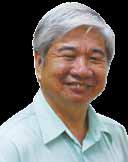
Currently these laws state that the British Standard is the accepted standard for use in Malaysia. If there are any changes in the standard used, then it will conlict with the by-laws.
Ir. Dr Chiang said IEM had studied the issue and came to the conclusion that the Eurocode was the way to go.
“ If we continue to use British Standard, we would be stuck in terms of advancement.
”
He said: “We have come to the conclusion that it is logical and reasonable to follow the steps taken by UK. In other words, we will adopt the Eurocode, in line with the withdrawal of the BS in Malaysia. So now, the problem is this: When is the deadline to do this?”
Through its Civil and Structural Engineering Technical Division, IEM has to set up a Position Paper Committee in 2002.
“Weinvitedallthevariousstakeholdersfromtheindustry, academia and government, private sector and so on, to come in together to discuss the options available once the British Standard is withdrawn in 2010. The standards are important because the practising engineers need to design according to certain standards so that the documents can be submitted for approval by the authorities.”
The authorities involved are local councils such as Dewan Bandaraya Kuala Lumpur (DBKL) and Majlis Perbandaran Petaling Jaya (MPPJ).
“The British Standard was accepted because it had been stated or provided for in the Uniform Building By-Laws (UBBL) in Malaysia as outlined by the Ministry of Housing and Local Government, which is the custodian of the building by-laws,” said Ir. Dr Chiang.
Ir. Dr Jeffrey Chiang “ A key improvement in the new standard is that Eurocode allows for a National Annexe which is, essentially, another document to supplement the main code ormain standard.”
Ir. Dr Jeffrey Chiang
In the UK, the BS was oficially withdrawn and the Eurocode fully adopted in March 2010.
“Prior to that, there was a two-year transition period during which engineers could choose to use either the BS or Eurocode in their work,” he said. That transition period allowed local engineers to familiarise themselves with and learn to use the Eurocode. After the two-year transition period, they would drop the BS totally. Currently, they are fully compliant with Eurocode.
“Similarly, Singapore, a Commonwealth country, faced the same dilemma but they were quicker in making a decision. In April 2013, they decided to start the twoyear transition period. By May next year, Singapore will fully comply with the Eurocode standards and BS will be withdrawn,” said Ir. Dr Chiang. “In Malaysia, we are facing a situation where we haven’t come to a decision yet. The Ministry of Housing and Local Government has yet to make a decision. We were told in late 2012 that the UBBL was being revised after receiving input from all the professional bodies including IEM. We haven’t seen the actual revision yet but we are told that the Eurocode is now included or has replaced the BS in the revised UBBL 2012 version.
by Ir. Prof. Dr Jeffrey Chiangby Ir. Tu Yong Eng
“But there is a snag. The Ministry cannot enforce the adoption of Eurocode in line with UBBL because it has to be enforced by the local authorities. They are the ones which gazette, implement and enforce and they haven’t done this yet. We were informed that the Selangor State Secretariat had already accepted or gazetted the UBBL revised version. However, it has to be accepted by all the other local authorities and not just the Selangor State Secretariat,” he said.
Ir. Tu added that every country could publish the NCCI documents, on condition that it is not in conlict with the main text. It only serves as a complementary document to the main text.
“ IEM also is keen to organise seminar courses, awareness talks and dialogues as part of the partnership programme with Standards Malaysia.
”
Ir. Dr Jeffrey Chiang
“A dilemma has surfaced. When we approached MPPJ, it said it was not aware of the changes. It had yet to come to a decision. In other words, it cannot be enforced for now. Our own professional members here have also come to a seek advice from the Institution.”
MATTER oF nAME
Ir. Dr Chiang said IEM had been working with Standards Malaysia ever since the presentation of the IEM Position Paper in early 2004.
“Up to now, we have already worked together with Standards Malaysia to produce the MS standards in line with Eurocode. They named it as MS EN. It’s a Malaysian Standard but adopts Eurocode as the basis. It’s the same as Singapore, which also uses the same sort of name – SS EN. In the UK it is BS EN. That’s how they name it. Different names are used in different countries, but essentially it is the same Eurocode,” he said.
Ir. Tu Yong Eng, another member of the committee, said the key difference was whether it was mandatory or not.
“Rightfully, in Malaysia, we can use it. In the current practice, we can also use the American standard and the Australian standard and so on,” he said.
Ir. Tu said that for a country to adopt the Eurocode, they must irst publish a National Annexe.
“Eurocode usually consists of three parts. The main text will be the same for all countries adopting Eurocode. This means that for Germany, Denmark, UK, Malaysia and Singapore, the irst part will be the same document. The second part varies from country to country. It is called the National Annexe. Then, the other third document is called the Non-contradictory, Complementary Information or NCCI document,” he said.
“When we adopted the British Standard, we adopted it in full in most cases. But for the Eurocode, we have to publish our own National Annexe. This is the main difference compared to the previous BS. We have set up a lot of technical committees, not only to adopt draft the Eurocode, but also to serve as the training ground for trainers. This means we should get a group of experts who are well versed in the document. In a way, we do not want to adopt a standard where Malaysia may not have the supporting technical documents and experts.
locAl conTEnT ThRoUgh ThE UsE oF nATIonAl AnnEXEs
A key improvement in the new standard is that Eurocode allows for a National Annexe which is, essentially, another document to supplement the main code or main standard.
“The National Annexe allows local parameters to be included. For example, variables like local weather condition, local practices and materials which are indigenous to a country. All these are local conditions or parameters which we can put into the National Annexe to go with the Eurocode. In practice, countries can adopt the Eurocode, but they can still adopt local conditions as well,” said Ir. Dr Chiang.
In that sense, he added, IEM has already drafted and produced the MS EN documents with Standards Malaysia, which comprise a total of 10 documents encompassing concrete design, steel design and geotechnical design.
“It is still not completed. We have just inished the irst parts of ive Eurocodes. However, each one Eurocode has multiple chapters. To be frank, it will take many years to complete. The irst parts are already available through Standards Malaysia. It is the owner of this standard. IEM is working on its behalf. It is the one that will sell or distribute to the users,” he said.
“ The Eurocode is a state of the art international standard which many countries in the region, in particular Commonwealth countries, will adopt.”
Ir. Dr Jeffrey Chiang
While many of the documents are already available, Ir. Dr Chiang said there is still a lot of work to be done.
“It’s still ongoing… the work of producing the necessary MS EN
documents. The work has never stopped. Standards Malaysia is also asking us to promote it. This is why IEM is holding a lot of seminars and courses as well as awareness talks and so on, to publicise it to our members and other stakeholders in the industry. This is what we are doing now with Standard Malaysia in a partnership arrangement,” he said.
pRogREss AchIEVED bY IEM TEchnIcAl coMMITTEEs
According to Ir. Dr Chiang, there are currently a total of 58 documents.
“There are a total of 10 parts. Each topic has sub parts. If you count all sub parts together, then you have a total of 58 documents. It takes time to publish the National Annexe. Of course you may not publish all, as some parts may not be relevant or important, for example, structural aluminum which not many people actually use,” he said.
The codes that have currently been documented are as follows:
• MS EN 1990 - Basis of Structural Design - the key code
• MS EN 1991-1-1 - Actions (Loading)
• MS EN 1992-1-1 Concrete Structures Design
• MS EN 1993-1-1 Steel Structures Design
• MS EN 1997-1-1 Geotechnical Engineering These are the ive codes already published as MS EN. Each has an accompanying National Annex.
The IEM technical committee is also working on the Eurocode 8 or MS EN1998-1-1forearthquake design and MS EN 1991-1-4 on wind loading. This process is still ongoing. IEM will form technical committees to address other parts of the concrete and steel design which have not yet been completed.
undergraduate students using the Eurocode as the basis for standards.
It would also allow IT software companies to upgrade software to include Eurocode and for the local authorities to be prepared.
“After all, local authorities are ones which have to approve all submissions by practising engineers for the approval of building design and so on. So they should be well versed in Eurocode,” stressed Ir. Dr Chiang who added that the three-year period should be long enough for the authorities to familiarise themselves with this knowledge.
IEMiscurrentlyworkingcloselywithStandardsMalaysia to contact and coordinate with government agencies such as the Public Works Department, the Construction Industry Development Board (CIDB), DBKL and various other engineering bodies as well as interested parties.
It also is keen to organise seminar courses, awareness talks and dialogues as part of the partnership programme with Standards Malaysia, which is keen to promote the use of the Malaysian standard. That is their objective. IEM wants to get local engineers to upgrade themselves, said Ir. Dr Chiang.
“The Eurocode is a state of the art international standard which many countries in the region, in particular Commonwealth countries, will adopt. Countries like Singapore, South Africa, India and Hong Kong will be using this code because the British Standard will no longer exist. So there is no point in sticking to the old standard,” he said.
“ In order to be competitive in the region and globally, the Eurocode must be adopted.”
Ir. Dr Jeffrey Chiang
ThREE-YEAR TRAnsITIon pERIoD
InApril 2014, the three main engineering bodies in Malaysia – IEM, the Board of Engineers Malaysia (BEM) and the Association of Consulting Engineers Malaysia (ACEM) –met and drafted a letter which was addressed to the Ministry of Housing and Local Government, seeking its agreement to commence a transition period, like what was done in the UK and Singapore.
“In that letter, we stated that the transition period should startfrom1stJunethisyear.Insteadoftwoyears,wewanted a three-year period starting 1st June, 2014 and ending in May, 2017, to give us more time,” said Ir. Dr Chiang. He felt that three years should be long enough for the local authorities to push enforcement, for local engineers to learn up on the code and for universities to teach
ThE MAIn chAllEngEs
The biggest challenge is changing the mindset, said Ir. Dr Chiang. “The people here are slow to adapt to change. The word ‘change’ itself gives them the impression that they would need to do a lot more work to adopt a new code or a new standard. The Eurocode is not easy. The document itself is thick, and there are many provisions in it which require a lot of changes, in terms of philosophy,” he said.
“It is very different from the British Standard although the fundamentals are basically still the same. People, especially those in the middle management levels and higher, may not want to learn up the code because, as you know, they may be a bit rusty. In any case, they don’t do the actual design work anymore. They have already moved on to management. It’s the upcoming generation of engineers who will soon take over the industry.
“This is why we will allow them more time to catch up. Perhaps by next year, if the universities take up this issue of Eurocode, they will churn out graduates who are fully trained in Eurocode. Then slowly, the majority of engineers in Malaysia will be Eurocode trained,” he said.
Join Nottingham, Britain’s global university in Malaysia
Faculty of Engineering
Our Faculty of Engineering offers a range of internationally recognised foundation, undergraduate and postgraduate courses across a range of subjects.
All of our BEng and MEng undergraduate courses are fully accredited by the Engineering Council UK. Our MEng courses are also accredited by the Board of Engineers Malaysia.
• Chemical engineering
• Civil engineering
• Electrical and electronic engineering
• Environmental engineering
• Mechanical engineering
• Mechatronic engineering
Britain’s number Over
12 choice for graduate employers
international campuses in China and the UK
4,500
students from 70 countries study at UNMC
The Graduate Market in 2014 , High Fliers Research.
Discover more at www.nottingham.edu.my/courses
* QS World University Rankings 2013/14.
The University of Nottingham Malaysia Campus KPT/JPT/DFT/US/B19
Jalan Broga, 43500 Semenyih, Selangor Darul Ehsan
t: +60 3 8924 8000
w: www.nottingham.edu.my/make-an-enquiry
Ir. Dr Chiang added that even if senior engineers are reluctant to learn the Eurocode, they should encourage the younger generation do so. “Just accept the change. Don’t deny it, obstruct or insist that young engineers must still use the British Standard. There is no point in that,” he said. In order to be competitive in the region and globally, the Eurocode must be adopted.
“ We are not just competing with Singapore but also with up-and-coming countries like Vietnam, Cambodia and Thailand.”
Ir. Dr Jeffrey Chiang
“We are not just competing with Singapore but also with up-and-coming countries like Vietnam, Cambodia and Thailand.Allthesecountriesarebecomingmorecompetitive in terms of cross-border engineering projects. Once our doors are open, there will be an inlux of engineers from the region coming in. They will take over if we are not capable enough in terms of technology, knowledge and expertise,” said Ir. Dr Chiang.
“We are also exporting our services overseas. We have engineers working in Dubai, Arab and Africa. If they don’t use Eurocode, how can they compete against other countries? Will British or UK companies employ them? These are the challenges we have to face because the world is moving fast.”
Ir. Tu pointed out that another big challenge lies in the cost or budget for retraining. A lot of money would be required to do this and there would be other costs as well.
“For the industry to adopt the changes, the regulatory industry has to be upgraded in terms of the laboratory and testing methods. There will be some changes to the manufacturing process as well. These challenges are not easy to overcome.”

Ir. prof. Dr Jeffrey chiang choong luin is currently the Dean of the Faculty of Engineering & Built Environment at SEGi University. His research interests are in structural behaviour of concrete structures in shear, wind loadings and earthquake design for structures.
He is an alumni of the Wollongong University NSW Australia. He graduated with a BEng (Hons) Civil, in 1991 and obtained his PhD in 1995. Before pursuing a career in the academia, he worked as a structural engineer with Arup Jururunding Sdn Bhd KL. He played a key role in drafting the Malaysian Standards on design of concrete structures (as TC Secretary). He is now serving as Chairman of IEM Technical Committee on Earthquake, and formerly chaired the IEM Technical Committees on Wind Loading Previously, he was Chairman of the IEM Civil & Structural Engineering Technical Division, and served as the IEM Honorary Secretary and Treasurer. Recently he was elected again as Honorary Treasurer of IEM. He was also the former WG coordinator on design of the International Committee on Concrete Model Code for Asia.
Ir. Tu Yong Eng is a professional engineer and amateur mathematician. He has extensive experience in civil and structural, design and construction. He has been continually involved in education and research, participating and organising various courses, seminars and conference. He was a member of various technical committees which drafted several Malaysian Standards. He was also an advisor to several local colleges and universities.
Ir. Tu held several key positions in The Institution of Engineers Malaysia. He is a Council member of the IEM (2008-2011, 2012-2015), Advisor for Civil and Structure Engineering Technical Division (2009-2011), Committee member, 9th (2006) 10th (2009) and 11th (2012) International Conference on Concrete Engineering And Technology, Secretary, IEM Position paper on the Prevention of Collapse of Scaffolding and Temporary Works. He has published more than 10 papers in both local and international bulletins and conferences.
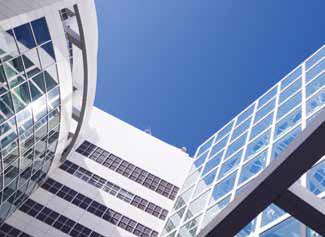
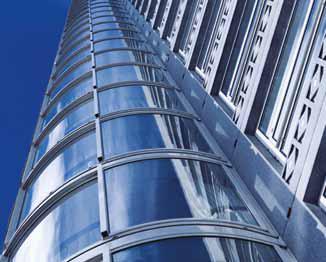
Implications and Timeline to Implement Eurocodes in Malaysia

1.0 iNTROduCTiON
In May 2010, UK withdrew British Standards relating to structural design and implemented Eurocodes. Singapore followed suit, but it also introduced a transition period of two years (from April 2013), during which period both British Standards and Eurocodes would co-exist for application and submission for approval purposes by the local authority.
So what are Malaysia’s plans to introduce and implement the adoption of Eurocodes in the construction industry here? How can The Institution of Engineers Malaysia (IEM) play a role in providing the incentives and support to ensure that the transition from BS codes to Eurocodes is carried out in a smooth and systematic manner?
2.0 sigNifiCaNCE Of ThE issuE aT haNd – implEmENTaTiON Of EuROCOdEs iN malaysia
At the moment, the decision-makers are not aware of the seriousness in the switchover of design standards for structural design from BS to Eurocodes. It all boils down to the provisions in the Uniform Building By-Laws (UBBL) in which it currently still stipulates the use of British Standards as the de facto approved standards for submission purposes.
The custodian of the UBBLis the Ministry of Housing & Local Government, while the Local Authority is the body that implements the policies or provisions therein.
Back in 2002, IEM mooted the formation of the IEM Position Paper Committee to draft a Position Paper titled “Design Standards for Concrete Structures in Local Construction Industry After 2006”.
At that time, UK had given an undertaking that it will introduce Eurocodes as the structural design standards to replace the British Standards in use at that time – such as BS 8110 (for concrete structures) and BS 5950 (for steel structures), to name two.
Since then, IEM has produced the following MS EN 199x documents based on Eurocodes, which are published by Standards Malaysia or the Department of Standards Malaysia (DSM):
• MS EN1990:2010 – Eurocode: Basis of Structural Design (RM120)
• NA to MS EN1990:2010 – Malaysia National Annex to Eurocode: Basis of Structural Design (RM20)
• MS EN1991-1-1:2010 – Eurocode 1: Actions on Structures – Part 1-1: General Actions – Densities, Self-weight, Imposed Loads for Buildings (RM50)
• NA to MS EN1991-1-1:2010 – Malaysia National Annex to Eurocode 1: Actions on Structures – Part 1-1: General Actions – Densities, Self-weight, Imposed Loads for Buildings (RM20)
• MS EN1992-1-1:2010 – Eurocode 2: Design of Concrete Structures – Part 1-1: General Rules and Rules for Building Structures (RM230)
• NAto MS EN1992-1-1:2010 – Eurocode 2: Malaysia NationalAnnex to Design of Concrete Structures – Part 1-1: General Rules and Rules for Building Structures (RM30)
• MS EN1993-1-1:2010 – Eurocode 3: Design of Steel Structures – Part 1-1: General Rules and Rules for Building Structures (RM100)
• NA to MS EN1993-1-1:2010 – Eurocode 3: Malaysia National Annex to Design of Steel Structures – Part 1-1: General Rules and Rules for Building Structures (RM20)
• MS EN1997-1:2012 – Eurocode 7: Geotechnical Design – Part 1: General Rules (RM170)
• NAtoMSEN1997-1:2012–Eurocode7:MalaysiaNationalAnnextoGeotechnical Design – Part 1: General Rules (RM30)
These are available for purchase online or at Department of Standards Malaysia’s headquarters in Cyberjaya.
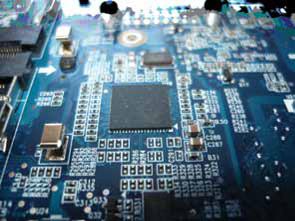
by Ir. Prof. Dr Jeffrey Chiang
3.0 ThE kEy dOCumENT – ThE uNifORm buildiNg by laws (ubbl)
It must be highlighted that construction engineering practices in Malaysia are largely governed by the provisions in the Uniform Building By Laws (UBBL) – which has its latest amendments being approved in 2012. And the latest amendments in the UBBL 2012 include the replacement of British Standards by Eurocodes being adopted as Malaysian Standards, named as MS EN standards, particularly for documents already prepared for concrete and steel design and others, as stipulated above.
Therefore, in order for the construction industry and related professional engineering practices to move forward, it is imperative that Eurocodes be used eventually as the referenced design standards for submission purposes.
However, not all local authorities have started to implement the revised UBBL, even though Selangor State has oficially adopted the revised UBBL. This has yet to be iltered down to the level of the local authorities.
4.0 TimEliNE fOR implEmENTaTiON
The three main engineering bodies in the country – Board of Engineers Malaysia (BEM), The Institution of Engineers Malaysia (IEM) and Association of Consulting Engineers Malaysia (ACEM) –came together and drafted a letter dated 5th June 2014, addressed to the Ministry of Housing and Local Government (Kementerian Perumahan dan Kerajaan Tempatan, KPKT) to inform the Ministry of the Joint Stand taken by them with regards to the adoption and implementation of MS EN Eurocodes in Malaysia.
The three had come to the consensus that a proposed 3-year transitional period (or moratorium period) would be a good way to tackle the implementation of Eurocodes, as it would allow suficient time for local practitioners to be familiar with the new standards. This was in line with other countries which had adopted similar measures. For example, UK implemented a 2-year transition period (2008 to 2010) and Singapore has put in place a 2-year transition period (April 2013 to May 2015).
In the letter to KPKT, it was suggested that the 3-year transition periodwouldstartfrom1stJune2014andendon31stMay2017.This would enable adequate preparation and training of local engineers and university engineering students on the use of Eurocodes in design courses, so that they would be ready by 2017.
Even the Ministry of Education can come out with a directive to all local public and private universities to conduct all design structural courses with references to Eurocodes, starting from, say, 2015. A 2-year period should be enough to fully implement Eurocodes into the teaching of relevant courses at university level. The teaching of design courses normally commences from Year 3 for a typical 4-year engineering programme. A 3-year UK-degree course would have design courses taught from Year 2. This is when the use of MS EN Eurocode 2 will have to be used in the teaching of design of concrete structures, in place of the withdrawn British Standards BS8110.
The use of Eurocodes will be more prevalent when students go on to take their Final Year Projects where emphasis will be on the use of design standards, and in integrated engineering design, where multi-disciplines are involved in the design of a typical project given to groups of students, most likely in Year 3.
Besides the education ield, the IT software industry will also require time to institute and to ine-tune the inclusion of Eurocodes as a design suite or package into commercial software. Currently, most if not all software packages in the market, have in place Eurocodes
as a choice of design standard for users, in order to process their analysis and design steps on using their commercial products.
Last but not least is the mindset of engineering graduates. Eurocodes are here to stay and, if graduates want to be competitive both locally and on the international arena, they deinitely have to be well-versed in the adoption and application of Eurocodes.
Figure 1 shows a representation of a tentative timeline and milestone for Malaysia, in adopting fully Eurocode as design standards in place of British Standards by 2017.
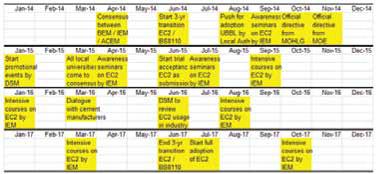
5.0 TRaiNiNg pROgRammEs as paRT Of aCTiON plaNs
Since2009,IEM,throughtheCivil&StructuralEngineeringTechnical Division, has been actively organising seminars and courses on Eurocodes, especially Eurocode EC2 (Concrete Design) as well as courses and workshops on Eurocode EC8 (Design for Earthquake Resistance).
Some of the more recent training seminars and courses offered or conducted by IEM on Eurocode 2 are:
• 17-18 October 2013, 2-Day Course on “Simpliied Uniied Practical Design to MS EC0, MS EC1 & MS EC2 From a Consulting Engineer’s Perspective”, by Ir MC Hee at Armada Hotel, PJ. (95 participants)
• 11 June 2012, 1-Day Pre CONCET 2012 Conference on “Design of Concrete Structures to EN 1992”, by Dr WMC McKenzie, PICC, Putrajaya. (61 participants)
• 21 May 2010, 1-Day Seminar on “Adapting Eurocodes EC0, EC1 and EC2 in Malaysia” by various presenters, Dynasty Hotel, Miri, Sarawak. (36 participants)
• 10-12March2010.3-DayCourseon“PracticalDesigntoMSEC0, MS EC1, MS EC2 from a Consulting Engineer’s Perspective”, by Ir MC Hee at Armada Hotel, PJ. (71 participants)
• 12 November 2009, 1-Day Seminar on “Adopting Eurocodes EC0, EC1 and EC2 in Malaysia” by various presenters at Puteri Paciic Hotel, Johor Baru (73 participants).
• 29 October 2009, 1-Day Seminar on “Adopting Eurocodes EC0, EC1 and EC2 in Malaysia” by various presenters at Evergreen Laurel Hotel, Penang (101 participants).
• 14 October 2009, 1-Day Seminar on “Adopting Eurocodes EC0, EC1 and EC2 in Malaysia” by various presenters at Armada Hotel, PJ (161 participants).
• 20 June 2009, Half-day Awareness Seminar on “EurocodesEC0, EC1 and EC2” by Ir MC Hee at UTAR Campus, PJ (101 participants).
It is IEM’s policy to charge relatively low attendance fees for courses that it organises, so as to enable maximum participation by stakeholders in the industry but priority will always be given to its members, whether they are students, graduates or corporate members.
Other than holding such public activities to generate publicity
Figure 1: Proposed timeframe for 3-year transition period towards full adoption of Eurocode by 2017
and knowledge on the use of Eurocodes, the IEM Library also has many volumes of up-to-date references and even software on the use and adoption of Eurocodes.
The only thing that is lacking is the availability of the Malaysian Standards MS EN publications, since Standards Malaysia does not appoint NGOs like IEM to be an agent in the sales of MS publications on IEM premises. Those who wish to purchase such publications have to contact Standards Malaysia or SIRIM.
IEM is in the midst of planning and organising a series of awareness seminar campaigns this year, in both the peninsula and Sabah and Sarawak. This is made possible with the SMART Partnership Programme between IEM and Standards Malaysia, in which the latter provided a sum of RM100,000 as a grant to promote the use of MS EN publications. IEM will also consider the possibility of bringing some MS EN documents (with the permission of Standards Malaysia) for purchase by interested participants.
6.0 whaT ms EN sTaNdaRd dOCumENTs ENTail
The following are brief descriptions of the developed and published MS EN documents which are essential for the adoption of main parts of Eurocodes for the local construction industry, principally on concrete and steel design as well as geotechnical design.
6.1 ms EN1990:2010 – EuROCOdE: basis Of sTRuCTuRal dEsigN
This is the must-read irst document because it sets the basis of structural design for all Eurocodes that follow from concrete design to steel design all the way to aluminium and timber design. It is the head key code for the harmonised Structural Eurocodes. MS EN 1990 establishes for all the Structural Eurocodes the principles and requirements for safety and serviceability and provides the basis and general principles for the structural design and veriication of buildings and civil engineering structures (including bridges, towers and masts, silos and tanks, etc.). MS EN 1990 gives guidelines for related aspects of structural reliability, durability and quality control. It is based on the limit state concept and is used in conjunction with the partial factor method.
6.2 Na TO ms EN1990:2010 – malaysia NaTiONal aNNEx TO EuROCOdE: basis Of sTRuCTuRal dEsigN
This has to be read together with the main document, MS EN1990, because it highlights the provisions which allow for local parameterswhichdonotconformexactlytoconditionselsewhere. Where required, local design parameters are recommended, otherwise those recommended by BSI will be adopted.
6.3 ms EN1991-1-1:2010 – EuROCOdE 1: aCTiONs ON sTRuCTuREs – paRT 1-1: gENERal aCTiONs – dENsiTiEs, sElf-wEighT, impOsEd lOads fOR buildiNgs
MS EN 1991-1-1 covers the assessment of actions for use in structural design due to:
• the density of construction materials and stored materials
• the self-weight of structural elements and whole structures, and some ixed non-structural items and
• imposed loads on loors and roofs of buildings (but excluding snow, which is covered by BS EN 1991-1-3, Snow loads).
The scope of MS EN 1991-1-1 is greater than for the appropriate BS codes (BS 6399-1 and BS 648). There remain some topics
(e.g. vertical loads on parapets and values for actions for storage and industrial use) that are not covered as comprehensively in MS EN 1991-1-1 when compared to BS 6399.
6.4 Na TO ms EN1991-1-1:2010 – malaysia
NaTiONal aNNEx TO EuROCOdE 1: aCTiONs ON sTRuCTuREs – paRT 1-1: gENERal aCTiONs –dENsiTiEs, sElf-wEighT, impOsEd lOads fOR buildiNgs
ThishastobereadtogetherwiththemaindocumentMSEN1991-11 because it highlights provisions which allow for local parameters which do not conform exactly to conditions elsewhere. Where required, local design parameters are recommended, otherwise those recommended by BSI will be adopted. For example, ireighting and rescue vehicle loads are adjusted accordingly in NA document to relect local context to differentiate from UK conditions. And AHU loor load is clearly spelt in the NA document – unlike in BS EN version.
6.5 ms EN1992-1-1:2010 – EuROCOdE 2: dEsigN Of CONCRETE sTRuCTuREs – paRT 1-1: gENERal RulEs aNd RulEs fOR buildiNg sTRuCTuREs
Dr Andrew Minton, of Concrete Centre, UK made the following statement on the application of Eurocode 2 in UK:
“In concrete design it is expected that there will be material cost savingsofupto5%comparedwithusingBS8110.Furthermore,the Eurocodes are organised to avoid repetition, they are technically advanced and should offer more opportunities for UK designers to work throughout Europe.”
The same can be said of Malaysian engineers when they get around to adopting and applying MS EN1992 Eurocode 2 in the local context.
MS EN1992-1-1 gives a general basis for the design of structures in plain, reinforced and pre-stressed concrete made with normal and lightweight aggregates together with speciic rules for buildings.
6.6 Na TO ms EN1992-1-1:2010 – EuROCOdE 2: malaysia NaTiONal aNNEx TO dEsigN Of CONCRETE sTRuCTuREs – paRT 1-1: gENERal RulEs aNd RulEs fOR buildiNg sTRuCTuREs
This has to be read together with the main document MS EN1992-1-1 because it highlights provisions which allow for local parameters which do not conform exactly to conditions elsewhere. Wherever required, local design parameters are recommended, otherwise those recommended by BSI will be adopted. The code drafters intended to produce non-contradictory complementary index (NCCI) for two speciic areas of local requirements, which are:
• Thin-sized structural elements in concrete beams and columns in single- and double-storey structures.
• Band beam design for large span concrete loor area.
6.7 ms EN1993-1-1:2010 – EuROCOdE 3: dEsigN Of sTEEl sTRuCTuREs – paRT 1-1: gENERal RulEs aNd RulEs fOR buildiNg sTRuCTuREs
Forsteeldesigners:Oncetheybecomefamiliarwiththeappropriate MS EN1993 documents (a signiicant task which includes the many parts of the Eurocodes, the national annexes and other
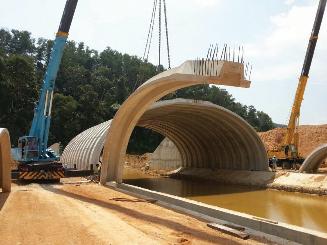
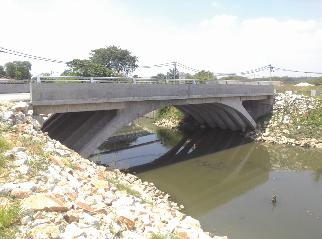
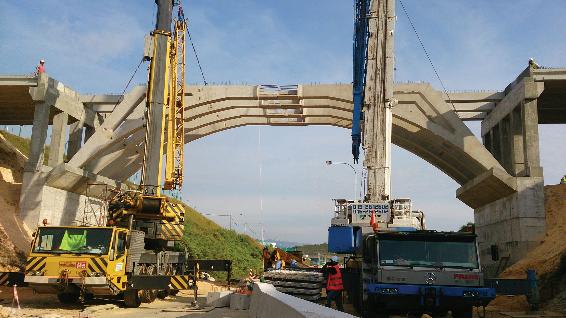
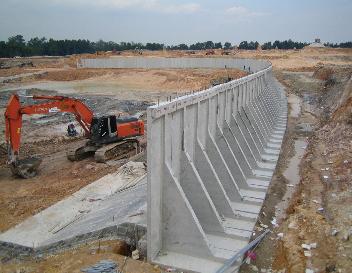

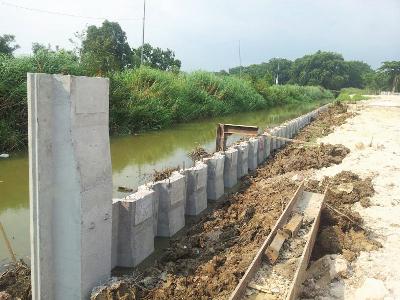
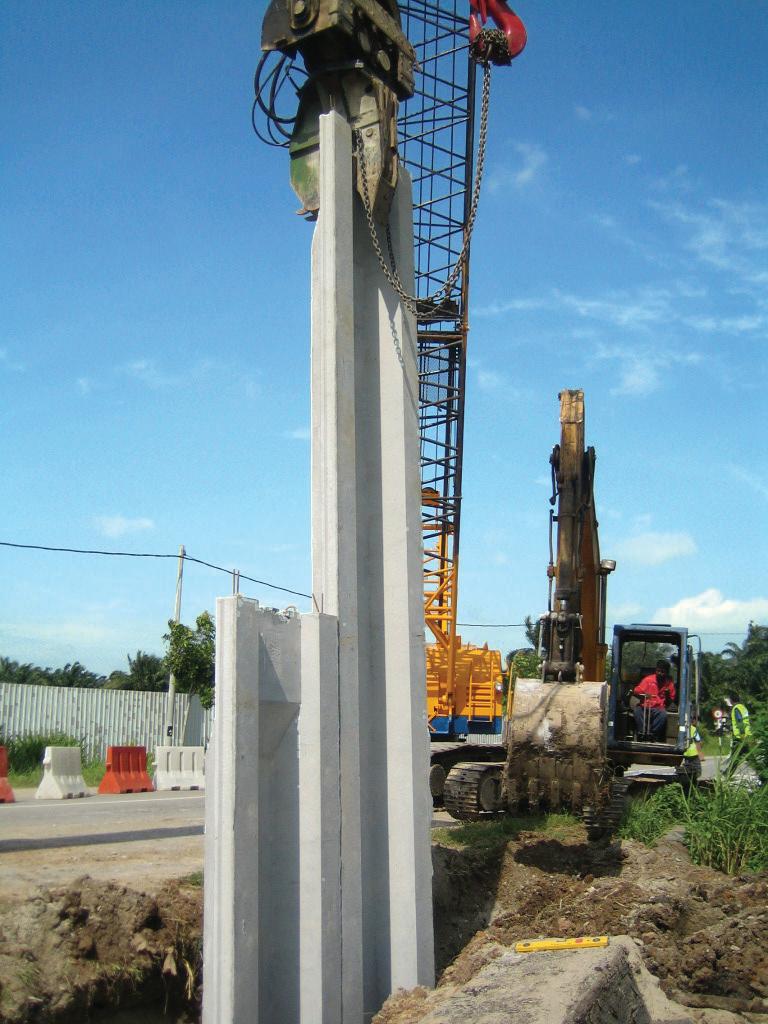
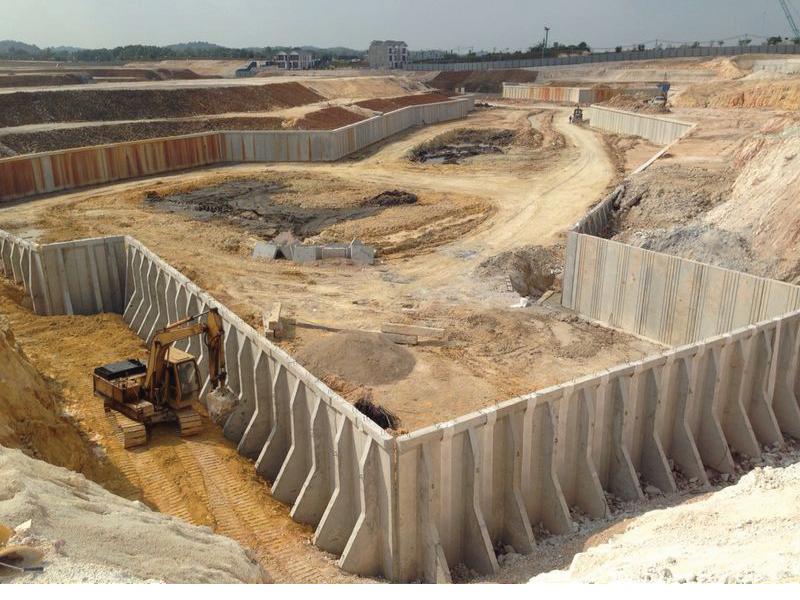
Concrete Sheetpile Concrete Retaining
Concrete Arch
support information), and familiar with the layout of the clauses within the Standard, the process will be reassuringly similar to design to BS 5950.
This general observation has some exceptions, such as combined axial loads and bending, but with some thought, it is easy to see that the underlying principles of structural mechanics are similar in both standards.
6.8 Na TO ms EN1993-1-1:2010 – EuROCOdE 3: malaysia NaTiONal aNNEx TO dEsigN Of sTEEl sTRuCTuREs – paRT 1-1: gENERal RulEs aNd RulEs fOR buildiNg sTRuCTuREs
This has to be read together with the main document MS EN1993-1-1 because it highlights provisions which allow for local parameters which do not conform exactly to conditions elsewhere.Where required, local design parameters are recommended, otherwise those recommended by BSI will be adopted. For more details of the local parameters used, readers are advised to purchase the relevant National Annex from Standards Malaysia, to get the full information.
6.9 ms EN1997-1:2012 – EuROCOdE 7: gEOTEChNiCal dEsigN – paRT 1: gENERal RulEs
By way of introduction, Andrew Harris and Dr Andrew Bond of Geomantix, UK have this to say on the Eurocode 7:
“For many geotechnical engineers across Europe, Eurocode 7 represents a major change in design philosophy, away from the traditional allowable (a.k.a. permissible) stress design involving a single, lumped factor of safety. The use of a single factor to account for all uncertainties in the analysis – although convenient – does not provide a proper control of different levels of uncertainty in various parts of the calculation.
“A limit state approach forces designers to think more rigorously about possible modes of failure and those parts of the calculation process where there is most uncertainty. This should lead to more rational levels of reliability for the whole structure. The partial factors in Eurocode 7 have been chosen to give similar designs to those obtained using lumped factors – thereby ensuring that the wealth of previous experience is not lost by the introduction of a radically different design methodology. The Eurocodes present a uniied approach to all structural materials and should lead to less confusion and fewer errors when considering soil-structure interaction.”
MS EN 1997 applies to the geotechnical aspects of the design of buildings and civil engineering works. It is concerned with the requirements for strength, stability, serviceability and durability of structures. It covers the following topics:
• Basis of geotechnical design
• Geotechnical data
• Supervision of construction, monitoring and maintenance
• Fill, dewatering, ground improvement and reinforcement
• Spread foundations
• Pile foundations
• Anchorages
• Retaining structures.
6.10 Na TO ms EN1997-1:2012 – EuROCOdE 7: malaysia NaTiONal aNNEx TO gEOTEChNiCal dEsigN – paRT 1: gENERal RulEs
This has to be read together with the main document MS EN1997-1-1 because it highlights provisions which allow for local parameters which do not conform exactly to conditions
elsewhere. Where required, local design parameters are recommended, otherwise those recommended by BSI will be adopted. For more details of the local parameters used, readers are advised to purchase the relevant National Annex from Standards Malaysia, to obtain the full information.
7.0 CONClusiON
The IEM Position Paper published in 2004, speciied the need to adopt Eurocode EC2 or, to be more precise, EN1992:2002 as the basis to draft the Malaysian Standards National Annex.
The intention was to institute a transition period which was proposed at 3 years, as agreed by BEM, IEM and ACEM. During this transition period, both Eurocode 2 and BS8110 can co-exist and be used as submission standards. The proposed transition period was from 1st June 2014 to 31st May 2017.
IEM, through its Civil & Structural Engineering Technical Division, has been actively organizing seminars and courses since 2009 on Eurocodes especially on Eurocode EC2 (Concrete Design) and Eurocode EC3 (Steel Design). Such activities will be continued intensively during the transition period, in collaboration with Standards Malaysia.
All the measures to enable a smooth transition to Eurocodes have to be implemented so that the practicing structural engineers can work within the required safety and economical needs of built design structures. This can be done with the co-operation and understanding of all relevant stakeholders in the construction industry.
REFEREncEs
[1] MS EN1990:2010 – Eurocode: Basis of Structural Design.
[2] NA to MS EN1990:2010 – Malaysia National Annex to Eurocode: Basis of Structural Design.
[3] MS EN1991-1-1:2010 – Eurocode 1: Actions on Structures – Part 1-1: General Actions – Densities, Self-weight, Imposed Loads for Buildings.
[4] NA to MS EN1991-1-1:2010 – Malaysia National Annex to Eurocode 1: Actions on Structures – Part 1-1: General Actions – Densities, Self-weight, Imposed Loads for Buildings.
[5] MS EN1992-1-1:2010 – Eurocode 2: Design of Concrete Structures – Part 1-1: General Rules and Rules for Building Structures.
[6] NA to MS EN1992-1-1:2010 – Eurocode 2: Malaysia National Annex to Design of Concrete Structures – Part 1-1: General Rules and Rules for Building Structures.
[7] MS EN1993-1-1:2010 – Eurocode 3: Design of Steel Structures – Part 1-1: General Rules and Rules for Building Structures.
[8] NA to MS EN1993-1-1:2010 – Eurocode 3: Malaysia National Annex to Design of Steel Structures – Part 1-1: General Rules and Rules for Building Structures.
[9] MS EN1997-1:2012 – Eurocode 7: Geotechnical Design – Part 1: General Rules.
[10] NA to MS EN1997-1:2012 – Eurocode 7: Malaysia National Annex to Geotechnical Design – Part 1: General Rules.
[11] BSI Structural Eurocode Companion, London, UK.
Ir. prof. Dr Jeffrey chiang is currently Honorary Treasurer of IEM. He has previously served as Honorary Secretary of IEM and is still serving as a member of IEM Technical Division of Civil & Structural Engineering, and as Chairman of IEM Technical Committee on Earthquake. He is also the Dean of Faculty of Engineering & Built Environment at SEGi University, Kota Damansara Campus.
Reliability Analysis for concrete structures
1.0 iNTROduCTiON
In structural engineering design, the concept of reliability was relatively new, although it was contained implicitly in most of the British Standards used before in the construction industry. However, it is now explicitly stated in the Structural Eurocodes. In other words, we believe the British Standard was reliable within the scope of its application in the industry, even though the level of reliability was not clearly stated in the codes. In EN 1990 [BSI 2004’, the concept of reliability can be found in section 2.2 and Annexes B and C.
Reliability in the context of structural design, is the ability of the designer to create a structure that fulills the intended design purposes and satisies the design requirements within the working life span of that structure. The objectives of this paper are as follows:
i. Explain the concept of reliability of the structure
ii. Establish the components of reliability and estimate the reliability level for material
ELECTEST
SDN BHD(67751-T)
PROMPT , PERTINENT , PROFESSIONAL
EstablishedSince1981
STRegisteredElectricalServicesContractor
DOBLE Ariicial Intelligence equipped Power System Diagnosics
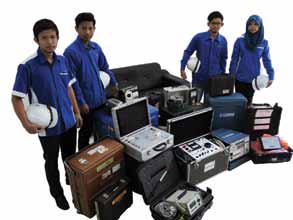
Specialists in Tesing, Commissioning & Maintenance of Electrical Installaions up to 275kV inclusive of Condiion Monitoring, Fault Invesigaion and Reciicaion
ElEctESt SDN. bhD. (67751-T)
STRegisteredElectricalServicesContractorupto500kV 3-G, 3-1, 3-2 Jalan C U20/C, Secion U20, TSBCommercialCentreSungaiBuloh, 40160ShahAlam,Selangor,Malaysia. Tel:+60361519495 Fax:+60361513930 Email:info@myelectest.com

iii. Compute the level of reliability based on the Eurocode EN 1992-1-1 provision for design concept.
Reliability is a statistical concept and is closely related to design return period. The concept of return period has always been misunderstood and confused with the design working life span of the structure. There are various terminologies which are also being used synonymous with return period such as Average Recurrence Interval (ARI) and failure probability within certain period.
In order to estimate the reliability level of the designed structure, it is common that Normal Distributions are assumed. The survival probability is deined by the chances the structure will survive within the stipulated time frame. The indicative measurement called a reliability index, β is related to the failure probability Pf such that:
Pf = Φ(-β) …………………………................... (Eqn 1) where Φ is the standard cumulative normal distribution. In a typical example, through indings by previous researchers [Chiang 2012], the reliability of the designed structure is a function of the following (which can be relected as reliability indices):
i. Properties of material used, ii. Expected loading to be exerted, nature and magnitude; iii. Workmanship or skills in implementation, and iv. Structural responses due to loading exerted.
2.0 REliabiliTy iN EN 1990
Section 2.2 of EN1990 explains the basic concept of reliability and practical method on how the reliability within assumption of the codes can be achieved. Reliability is customarily speciied for a period of one year and for the life span of the structure (normally 50 years) corresponding to the required limit states of design used. In general, different limit states and components exhibit different level of reliability.
Table B2 of Annex B, EN 1990 gives the speciic level of reliability for ultimate limit state of design as follows:
by Ir. Tu Yong Eng
Table 1: Reliability indices for reliability categories of design structures
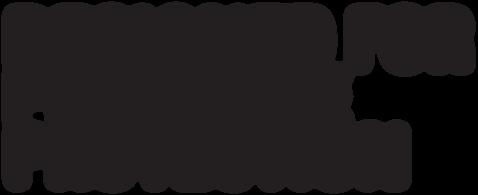
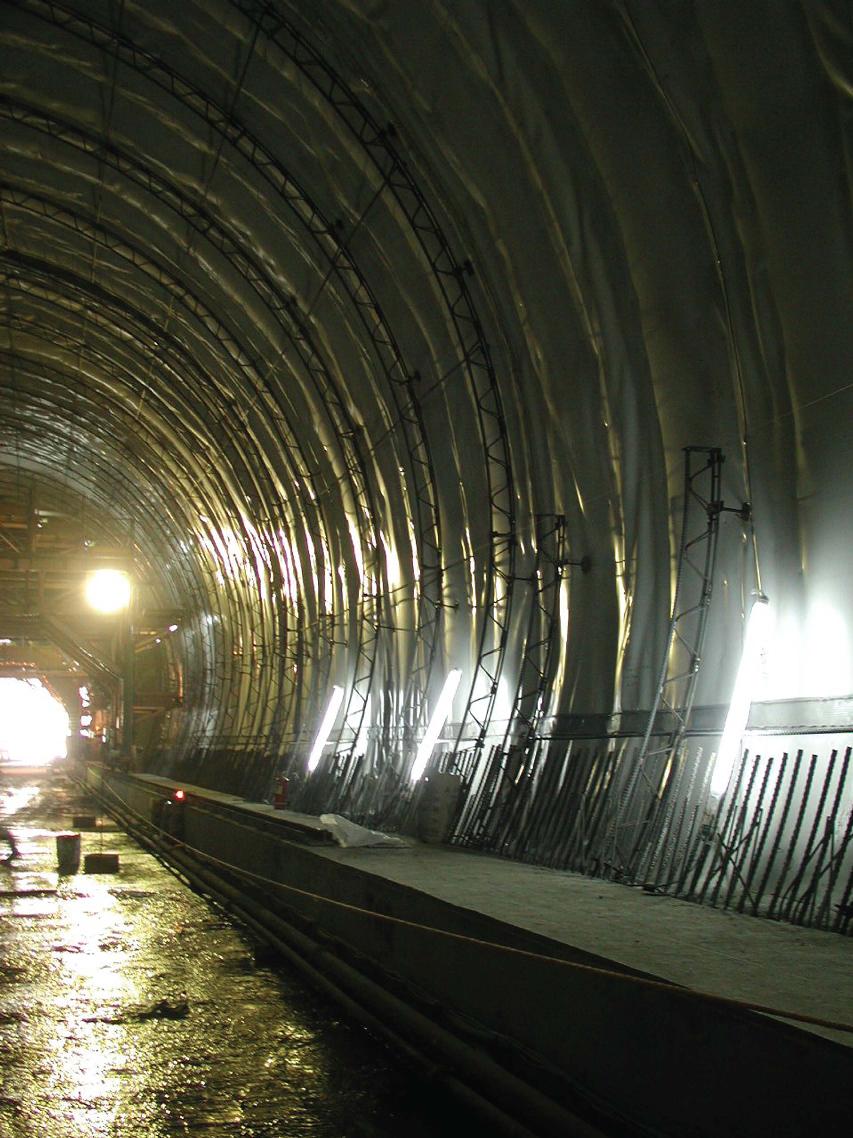
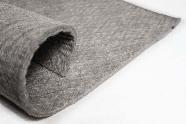
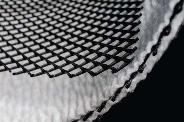
Based on the igure above, we can compute the failure probability using spreadsheet, as in Microsoft Excel. To compute the failure probability based on Equation 1, the formula NORM.S.DIST(β,1) can be used. Conversely, to ind the reliability index β from the failure probability, the function NORM.S.INV(p) can be used.
RC 3 9.96443E-088.53991E-06
RC 2 1.30081E-067.2348E-05
RC 1 1.33457E-054.83424E-04
3.0 RElaTiONship bETwEEN ThE RETuRN
pERiOd aNd REliabiliTy iNdEx
Many designers and researchers have the following common misconceptions about return period: i. Return period should be the same as the life span of the structures.
ii. To obtain data for high return period, we should have as many data as return period and hence, very high return period is irrelevant.
In fact, the return period and life span of the structures are not inter-related and to obtain high return period information, we do not need as many data as the number of years as in the return period. Just to reiterate, the return period is a statistical concept. Hence, suficient data is required if we are working with return period. Return period T is related to the occurrence probability within a year as follows: Pf = 1/T (Eqn 2)
So, for a 2,500-year return period wind speed, w2500 m/s is the wind speed that has only a 0.04% chance of exceeding w2500 within one year. Similarly, it has 2% chance to have wind exceeding wind speed with 50 years return period, w50 within one year.
For the phenomenon of return period, it requires that the condition remains unchanged throughout the study period and the parameter will be considered as a random variable. With these assumptions, the distribution is a binomial distribution. Therefore, we can compute the chances of the value being exceeded within any period as follows:
P n = 1 – (1-p1)n …………………………………... (Eqn 3)
In Equation 3, Pn refer to the probability of exceedance at least once within n year and p1 is the probability of exceedance at least once within 1 year.
Similarly, we can rewrite Equation 3 for reliability index β for phenomenon that remains uniform throughout the study period (such as wind and earthquake) as follows:
Φ(-βn) = 1 – (1 - Φ(-β1))n ……………………………(Eqn 4)
In Equation 4, βn refer to the reliability index for a period of
n year and β1 is the reliability index for 1 year.
In structure loading, permanent action will not be distributed as a binomial distribution, and hence will not satisfy Equation 4.
In the article by Tu (2008), the author has computed the chances of exceedance within various period based on the return period. For example, the chances of exceedance within 50 years for a return period of 2,500 years is 1.98%. It has 10% chances of exceedance within 50 years for event with 475 years of return period. For a structure with a life span of 50 years, if the collapse limit state is taken to be 475 year return period seismic event, then it will have a 10% chance of collapse within the life span of 50 years. This is obviously too high.
4.0 REliabiliTy iNdEx COmpuTaTiON fOR CONCRETE sTRuCTuREs
In order to achieve the necessary reliability, both EN 19921-1 and BS8110 [BSI 1997] have built in the necessary factorsintovariouscomponents.Formaterial,characteristic strength was speciied instead of the mean strength. In the practice, some confused between the characteristic strength and minimum cube strength. It should be pointed out that due to the different level of industry practices, the level of reliability of the structures will be different from country to country. Comparing the concrete data from Ray et al. [2014] and Chiang et al. [2012], there are huge different shown in the practices in Hong Kong and Malaysia. Therefore, it is the right time for the local industry to think about and take action on the quality of supplied concrete in Malaysia. The comparisons are as follows:
In both BS 8110 and EN1992-1-1, the reliability indexes for material supply are 1.64. On average, the reliability indexes of concrete supply were 3.407 and 1.351 for Hong Kong and Malaysia respectively.
For loading, two factors were introduced, i.e. characteristic loading and load factor. The characteristic loading was deined as the loading for which only certain prescribed probability being exceeded. However, the level of probability was not speciied in the code. In the extreme case, nominal value (or average value) would be speciied in some designs. For structural responses, partial factor has been introduced. Based on EN 13791, to cater to the workmanship for concrete, a reduction factor of 0.85 was introduced.
Table 3: Comparison of tested compressive strength of supplied concrete
Table 2: Maximum failure probabilities for reliability categories of design structures

Example 1:
Consider Ultimate Limit State for a simply supported beam with the following data:
a) Geometric data:
i. Length = 6 m
ii. Width b = 250 mm (Standard deviation of 10 mm)
ii. Depth h = 600 mm (Standard deviation of 25 mm), cover = 25 mm, link= 10 mm
b) Material data.
i. Concrete C25/30, fyk = 25MPa with standard deviation of 4 MPa;
ii. Steel reinforcement grade 500B, with fy = 500 MPa with a standard deviation of 35 MPa.
c) Loading data
i. Average permanent action = 31.5 kN/m with a standard deviation of 4.5 kN/m (14.3% of the characteristic loading);
ii. Average variable action = 10 kN/m with a standard deviation of 3 kN/m (30 % of the characteristic loading)
First we may ignore the geometric deviation. As usual, assuming the loading to be normally distributed, characteristic loading will be taken to be the 75 percentile loading. Hence, the loading are as follows:
a) Characteristic permanent action= 31.5 + 0.67 x 4.5 = 34.5 kN/m
b) Characteristic variable action = 10 + 0.67 x 3 = 12.0 kN/m
c) Using partial factors of 1.35 for permanent action and 1.5 for variable action, total design loading is 64.6 kN/m and the design moment generated is 290.7 kNm.
d) Based on the design, reinforcement required will be 3T25.
e) Total loading will be distributed according to normal distribution with mean of 41.5 kN/m and standard deviation of 5.41.
f) Moment due to the loading will be distributed according to normal distribution with mean of 186.75 kNm and standard deviation of 24.34. Hence, the probability of exceeding will be 9.64 x 10-6
g) Mean concrete strength is 25 + 1.64 x 4 = 31.56 MPa;
h) Mean yield strength of steel bar = 557.4MPa.
In the computation of the capacity of the section, the following formula was adopted (refer to Equation 3.15 and Figure 3.5 of EN1992-1-1, page 34 to 36):
i. Rectangular stress block was adopted;
ii. αcc taken to be 0.8 in accordance with the Malaysian National Annex.
iii. fcd = αcc fck /γC , with the material partial factor γc taken to be 1.
iv. λ = 0,8 for fck ≤ 50 MPa
v. λ = 0,8 - (fck -50)/400 for 50 < fck ≤ 90 MPa
vi. η = 1,0 for fck ≤ 50 MPa
vii. η = 1,0 - (fck -50)/200 for 50 < fck ≤ 90 MPa
Monte Carlo simulation is carried out to determine the failure possibility of the section. The capacity of the section has a normal distribution with the mean of 398.90 kNm and standard deviation of 23.05. The difference between the capacity and the moment due to loading, is normally distributed with a mean of 212.15 and standard deviation of 33.52. So the reliability of this section under Ultimate
Limit State is 6.329, corresponding to a failure probability of 1.235 x 10 -10
Based on EN13791, a reduction factor of 0.85 was introduced for the concrete strength of existing structures. So, taking the reduction factor of 0.85 to the strength of concrete as well as the steel bar, and geometric deviation into consideration, the capacity of the section has a normal distributionwithameanof338.7kNmandstandarddeviation of26.04.Therefore,thedifferencebetweenthecapacityand moment generated by loading is distributed normally with a mean of 151.95 kNm and a standard deviation of 35.6. The reliability is reduced to 4.263 and the failure probability is 1.0094 x 10 -5. The probability distribution graphs are shown in igure 1 below:
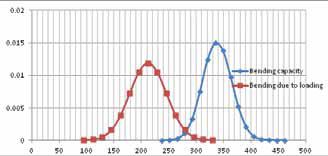
5.0 CONClusiON
It is important to know the assumed reliability of the speciic codes of practices so that the policy maker can determine if the recommendations are too stringent or insuficient. This is especially so for new forms of loading or environmental loading such as adoption of seismic design in Malaysia. As a state-of-the-art codes of practice, Structural Eurocodes have explicitly speciied the level of reliability for the structuraldesignandconstruction.Inthispaper,anexample was presented to illustrate the computation of the reliability of a section design for ultimate limit state.
REFEREncEs
[1] BSI (1997), BS 8110 Part 1, Structural use of concrete —Part 1: Code of practice for design and construction
[2] BSI (2002), BS EN 1990, Eurocode — Basis of structural design
[3] Chiang, J. C. L. , Tu, Y. E. and Tan, C. S. , (2012), “Gauging the reliability of structural design for buildings and infrastructures from Malaysian Engineers’ viewpoint”, The Twelfth East Asia-Paciic Conference on Structural Engineering and Construction (EASEC12),Hong Kong Special Administrative Region, China, 24-26 January 2011
[4] DSM (2012), NA to MS EN 1992-1-1, MS National Annex to Eurocode 2: Design of concrete structures — Part 1-1: General rules and rules for buildings
[5] Ray K.L. Su, Daniel T.W. Looi, Tim O. Tang, C.W. Law,( 2014) “Performance based seismic design for Tall Buildings in Hong Kong, Advances In Seismic Engineering” – Annual Seminar 2014, HKIE / IstructE Joint Structural Division.
[6] TuY. E. (2008), “The facts and myths of return period in earthquake engineering”, Bulletin of The Institution of Engineers Malaysia, March 2008.
Ir. Tu Yong Eng is a professional engineer and amateur mathematician. He has extensive experience in civil and structural, design and construction. He has been continually involved in education and research, participating and organising various courses, seminars and conference.
He was a member of various technical committees which drafted several Malaysian Standards. He was also an advisor to several local colleges and universities.
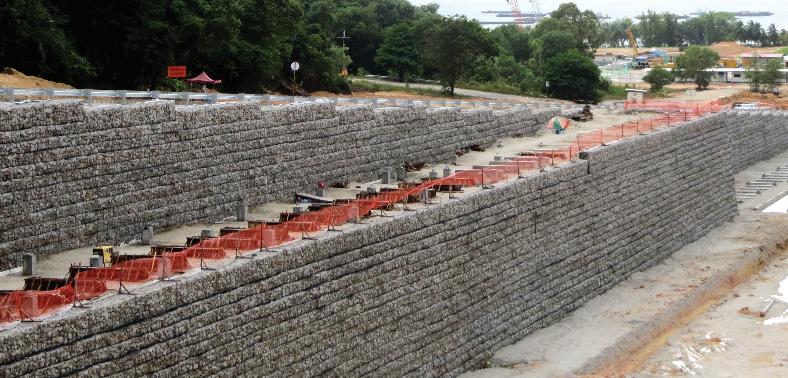


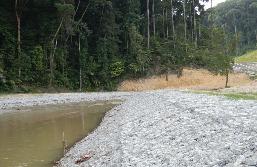





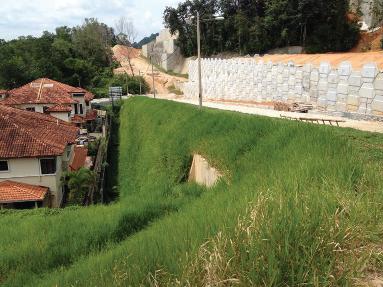




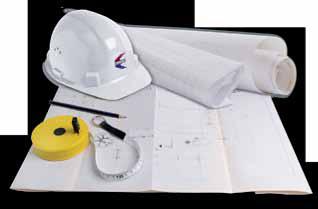



Eurocode 3: Design of steel structures BS EN 1993-18: 2005 Design of Joints Journey of the Malaysian Annexe

Design of Steel structures had come a long way since the introduction of BS5950 which led to a changeover from the Allowable Stress Methods to Limit State Design. This was further advancedwiththeintroductionofnewhighperformancematerials, fabrication methods and design which took advantage of the rapid progress and, in particular, the connections. Early connections of steel structures used rivets which were replaced with welded and bolted connections. Developments in automatic fabrications, 3D shop drawings with software connected to numerically controlled machines for laser cutting and punching, have moved away from traditional manual methods.
As a result, higher quality and standardisation are achievable due to automation. Today, steel connections are economical to fabricate and erect, have a high level of safety and results in elegant and practical structures.
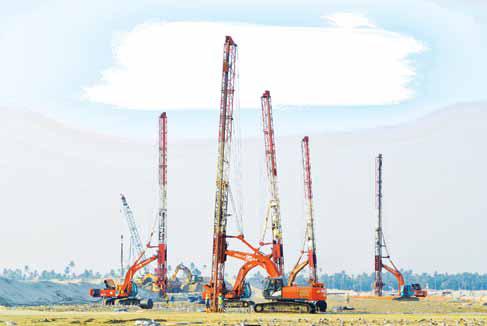
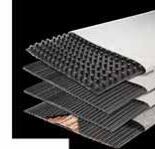
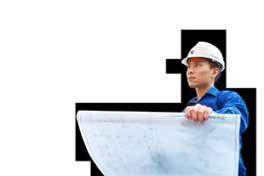
To take advantage of the above, Eurocodes standards were developed, taking into account various common design methods available throughout the EU, and consolidated into a single document. This way, a speciic steel standard for steel connections was created, unlike the BS5950 which was embedded in the main design document. The EuroNorm (EN) standards on joints have seen a dramatic increase in technical guidance,fromameager21pagesinBS5950to133pagesinthe EN 1993-1-8.
ThemethodsusedintheBritishStandards(BS)forconnections design were based on a series of capacity checks and there was no guidance or method for determining the connection stiffness and rotational capacity. Recent advancements in research and improved methods have made possible the derivation of stiffness and rotational capacity of bolted and welded connections. EN 1993-1-8 has utilised these advantages and included a series of consistent approach for calculating the strength, stiffness and rotational capacity of a limited and practical range of bolted and welded connections. The resistance of the joints is determined on the basis of the resistances of its basic components and the fasteners with higher shear stiffness should be designed to carry the design load.
The method is called the Component Approach and uses the behaviour of the individual component within a connection (bolts, weld, end plate, columns lange, etc) to simulate the connection’s load-deformation characteristic. This allows the designer to predict the behaviour of simple, continuous and semi continuous steel frames. This method is based on
by Ir. David Ng. Shiu Yuen Chairman for Technical Committee of EC3
research done on lush and extended end-plate and has been extended to include joints with angle cleats, composite and base plates.
In addition to beam to columns connections, EN 1993-18 also includes design methods for column bases with end plate connections, new rules for the interactions of moments and axial forces at the connections, new rules for calculating the bearing capacity of slotted holes, welded connections to tubes and improved serviceability limits for pins.
There are some subtle differences in the EN 1993-1-8, in the detailing limitations such as maximum bolt spacing (max. 16t to 14t for all conditions), holes sizes (for calculations of shear capacity – no reduction if less than 1mm clearance for M12 and M14), no edge distance rules when the holes are not in the direction of the forces.
These differences should not have much impact on the connection resistance compared to other standards, including the withdrawn BS5950. Having said that, the materials factor in EN1993-1-8, i.e. γm2 = 1.25 for materials, means the joints should have a more conservative value compared to BS5950. In the overall joint capacity calculations the materials factor in the United Kingdom (UK) National Annexe (NA) for BS EN1993-1-1, γ0 = 1.00 and γm2 = 1.10 ( EN 1993-1-1, γm2 = 1,25).This translates to more economical sections and a heavier connection as opposed to BS5950 where γm = 1.00, regardless of whether it is sections or joint capacity. This is a signiicant departure in terms of reliability between sections and joints.
In the UK NA, on which the Malaysian NationalAnnexe (NA) will be modelled closely, the connections classiications of pinned and rigid can be based loosely on the SCI publications (NCCI – non-contradictory complementary information) and
this assertion can greatly reduce or eliminate complicated calculations. The inluence of NA in the EN document is critical and should not be overlooked as it can make signiicant changes to the Eurocode core.
The group of committee members in the Malaysia NA drafting committee has a major role in balancing the local available resources and new developments. This is to ensure we have an NA document that is relevant to the industry and, at the same time, pays homage to the original document which was painstakingly prepared by a panel of world experts.
Ir. David ng. shiu Yuen is the current Chairman for Technical Committee of EC3
IEM DIARY oF EVEnTs
one-Day course on Drilling Engineering overview
Organisedby :Oil,GasandMiningTechnicalDivision
Date :20thSeptember2014
Time :8.30a.m.–5.00p.m.
Venue :WismaIEM
CPD/PDP: :6.5
One Day Symposium on Protecion Against Lightning
Organisedby :ElectricalEngineeringTechnicalDivision
Date : 27thNovember2014
Time :9.00a.m.–5.00p.m.
Venue :GrandDorset,Subang,Malaysia
CPD/PDP: :6.0
Kindly note that the scheduled events below are subject to change. Please visit the IEM website at www.myiem.org.my for more informaion on the upcoming events.
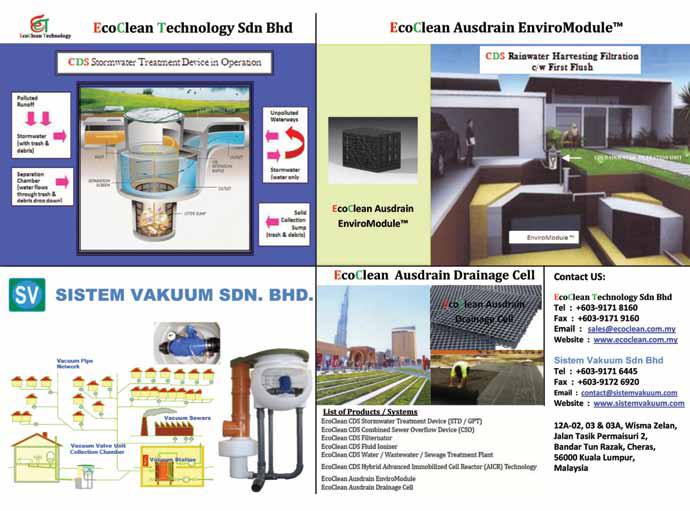
After Dark, Making Tracks in The ground
In the dead of night, when most people are at home sleeping, more than 20 people are 30m below Jalan Bukit Bintang in an underground tunnel. These are the tunnel engineers and ground crew who are working to complete the Mass Rapid Transit (MRT) line.
“We have two 12-hour shits and the night shit starts from 7pm to 7am,”said MMC-Gamuda yard foreman Mohd Zakiuddin Ridzuan, 31. “Iniially, we needed some ime to adjust but now, we are already used to it.”
Workers have to walk in a narrow 1.1km walkway because it is the only way to reach the tunnel boring machine (TBM) and the tunnel is equipped with electricity to light the path for them.
The work of this overnight tunnelling team certainly looks old-fashioned hard labour because they have to brave dirty water with paricles in the air entering their lungs. With the sound of generators running, it feels like an arillery barrage echoing in this nocturnal subterranean world when everyone is shouing over it.
Travelling down through the circular shat to the pit botom, precision is key when it comes to cuing out the tunnels using a tunnel boring machine. “We are using a variable density TBM because it is designed to dig through karsic limestone, which is more complex as it contains pockets of water and large void chambers that can cause sinkholes on the surface,” said MMCGamuda construcion manager Yusni Shahadan, 48.
The danger with water while tunnelling is that if the TBM were to hit a water pocket, the pressure would force the water out and may lood the area, Zakiuddin said.
“The high pressure of the water gushing out could cause a lot of damage. It can even afect the TBM and tunnelling will have to be stopped, delaying the MRT construcion,” he said.
(Sourced from Malay Mail, 9th August 2014)
petronas is best Employer
PETRONAS has won the 5th Asia’s Best Employer Brand Awards 2014 in Singapore, cemening the oil and gas mulinaional’s posiion as one of the most reputable employers in the industry and region.
The award recognised Petronas for its eforts and investment in enhancing its human capital development, as well as human resource pracices, policies and strategies towards ofering appealing value proposiion to increasingly diverse talent segments.
Petronas senior vice-president of group human resource management Raiha Azni Abdul Rahman
said: “Petronas has always believed in ‘building own imber’ to ensure we have a sustainable pool of talent to support the future growth and expansion of our businesses.”
The group is currently working on a number of iniiaives to encourage educaional foundaions and capability development of its talent as well as extending this to the local community as part of its corporate social responsibility in building pipeline of educated ciizens.
“We coninuously leverage on our own learning insituions such as Petronas Leadership Centre to nurture business-oriented leaders, Insitut Teknologi Petroleum Petronas to build technical skills, Universii Teknologi Petronas (UTP) to produce oil and gas technical graduates and research technologies and Akademi Laut Malaysia (ALAM) as a Centre of Excellence for mariime educaion and training,” she said.
Asia’s Best Employer Brand Awards were jointly hosted by Employer Branding Insitute, World HRD Congress and Stars of the Industry Group, supported by CHRO Asia as strategic partner and endorsed by Asian Confederaion of Businesses.
(Sourced from NST, 2nd August 2014)
Romania Invites Malaysian Firms to Invest In Infrastructure, construction projects
Romania is inviing Malaysian companies to invest in its infrastructure and construcion projects like railways and highways.
ItsStateSecretaryforGlobalAfairsCarmenLiliana Burlacu said: “Malaysia is doing very well in these areas. We would like to see its technology being implemented in Romania as well, speciically in infrastructure and in energy sectors.”
The other sectors that had been opened up for foreign investment were agriculture, processed food, tourism, electrical and electronic sectors as well as oil and gas, she added.
Burlacu said foreign investments could either be undertaken through joint ventures or via 100 per cent ownership.
Romania is also keen to share its experise in energy sector including nuclear, thermo, hydro, wind and solar technology.
(Sourced from NST, 2nd August 2014)
Malaysia and Japan Team Up To produce Animation series
A mulimedia super corridor (MSC) status company, Creatvtoon Studios Sdn Bhd
(Creatvtoon) and renowned Japanese content provider P.I.C.S. Co Ltd (P.I.C.S.) have teamed up to produce an animaion series.
A memorandum of understanding was signed here by P.I.C.S president/chief execuive oicer Shinichiro Nakaso and the founder/director of Creatvtoon, Ayie Ibrahim.
Shinichiro said the cooperaion is aimed at bringing together the experise of both companies to produce creaive content that will use storylines from Malaysia and Japan.
The cooperaion is the result of the iniiaive by the Mulimedia Development Corporaion (MDeC), under its Malaysian Creaive Industry Policy.
(Sourced from Bernama, 27th August, 2014)
local Demand For highend condominiums Expected to Weaken
Local demand for high-end condominiums is expected to weaken in the next 12 months, primarily in the Kuala Lumpur City Centre (KLCC) area, with more developers anicipated to tap foreign markets.
Jones Lang Wooton Execuive Director Malathi Thevendren said the projecion is based on the mismatch in the level of pricing by developers with local afordability.
“There are not many people who can actually aford to buy the high-end condominiums. Some developersareevenholdingbacktheirlaunches... (as) they know there’s no market,” she said. For afordable condominiums, Malathi said demand will see steady growth with young couples and professionals coninuing to drive the market.
(Sourced from Bernama, 27th August, 2014)
Icon wins RM297m ship supply pact
Icon Ofshore Bhd has won RM297 million contracts to supply a workboat and two anchor handling tug and supply vessels. Its unit Icon Bahtera (B) Sdn Bhd has inked a deal to provide one accommodaion work boat to Zell Transportaion Sdn Bhd, with Brunei Shell Petroleum as the end customer.
Another unit, Icon Ofshore Group Sdn Bhd recently received a leter of intent to extend a contract from an internaional oil and gas service provider to provide two anchor handling tug and supply vessels.
(Sourced from NST, 15th August 2014)

getting the Right Proile

by Ir. Shum Keng Yan
Remember the Safety Triangle (Accident Triangle)? In reality, for normal companies, the triangle will often look like a rocket due to under-reporting of Near Misses in the red zone (refer to February and March 2010 articles).
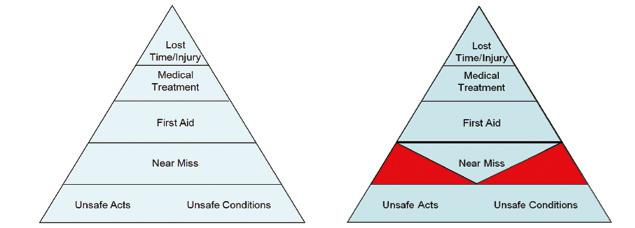
Now that you are armed with the knowledge of Group A and Group B incidents (May and July 2014 articles), perhaps we need to re-evaluate the focus we pay to Near Miss. Not all Near Misses are the same! Trying to get the numbers to make a triangle should not be the priority.
Many companies use Near Miss as a proactive (leading) indicator due to convenience and also because “others” are using it. By far, Near Miss is a reactive (lagging) indicator. An accident has happened and by chance, has not resulted in injuries. It is only by chance that Near Miss has not turned into a Recordable Case. Think of Near Miss as the technical term for “luck”. You can cut and dice and re-arrange the theories but the bottom line remains that the accident has occurred and it is just lucky that there are no injuries.
Now if we are to balance our focus, perhaps we should focus on what is called the Potentially High Impact (PHI or ) Near Misses. They are the Near Misses that can lead to Group A incidents! PHI events need to be identiied and investigated as vigorously as Recordable Cases.
This does not mean we can ignore the other cases. It just means that we need to allocate our resources using a more prudent approach.
Here are 5 tips on how to further analyse your data:
1. Analyse a minimum period of 5 years (or two long-term plan cycles).
2. Look at “high” seasons, corresponding with peak periods of activity.
3. Try to see if there is a trend of certain incidents happening at certain time.
4. Get an independent person to go through your analysis to take away biases.
5. Share your data with the line management for validation.
6. Step back and see if there is a bigger pattern emerging from all the incidents.
To share your trends, email us at: pub@iem.org.my
All leading indicators are actually derived from a lagging event. It is how far ahead that we want to go, that deines our measure of proactiveness.
The safest risk is the one that you did not take. Often it is the gap in the risk perception that leads to a gap in risk control.
Ir. shum Keng Yan is a chemical engineer and a certiied accident prevention and safety practitioner. He advises on EHS in the chemical, fast moving consumer goods, heavy metal manufacturing and building services industries across Asia Paciic and beyond. He regularly delivers talks at conferences, forums and universities.
Effects of Thunderstorm Winds in Determining suitable Wind speeds for Design of building structures in
peninsular Malaysia and Actions
1.0 iNTROduCTiON
1.1 ThuNdERsTORm wiNds
1.1.1 Deinition of A Thunderstorm
Athunderstorm, also known as an electrical storm, a lightning storm, thundershower or simply a storm, is a form of weather characterised by the presence of lightning and its acoustic effect on the Earth’s atmosphere, known as thunder. [Ref. 3].
According to Holmes [Ref. 4], thunderstorms - both isolated storms and those associated with advancing cold fronts – are small disturbances in horizontal extent, compared with extratropical depressions and tropical cyclones. But they are capable of generating severe winds, through tornadoes and downbursts.
Thunderstorms are usually accompanied by strong winds, heavy rain and, sometimes snow, sleet, hail or no precipitation at all. In tropical climate zones such as Malaysia, thunderstorms are associated with a burst of heavy rain and strong winds for a short period of time.
Strong and severe thunderstorms may rotate and this is a phenomenon known as super-cells. While most thunderstorms move with the mean wind low through the layer of the troposphere that they occupy, vertical wind shear may cause a deviation in their course at a right angle to the wind direction.
1.1.2 Formation of Thunderstorm and Its Effect on Strong Wind Generation
Thunderstorms result from the rapid upward movement of warm, moist air. They can occur inside warm, moist air masses and at fronts. As the warm, moist air moves upward, it cools, condenses and forms cumulonimbus clouds which can reach heights of over 20 km.
When the rising air reaches dew point, water droplets and ice form and begin falling down towards the surface of the Earth. As the droplets fall, they collide with other droplets and become larger. The falling droplets create a downdraft of air that spreads out on the surface of the Earth and causes strong winds associated with thunderstorms.
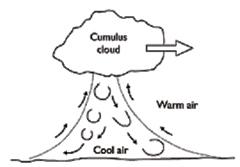


Thunderstorms can generally form and develop in any geographic location, perhaps most frequently within areas located at mid-latitude when warm moist air collides with cooler air. Thunderstorms are responsible for the development and formation of many severe weather phenomena. Thunderstorms and the phenomena that occur in relation to them, pose great hazard to populations and landscapes. The resulting damages are mainly caused by downburst winds, large hailstones and lash looding caused by heavy precipitation. Stronger thunderstorm cells are capable of producing tornadoes and waterspouts.
1.1.3 Classiication of Thunderstorms
There are four types of thunderstorms: Single-cell, multicell cluster, multi-cell lines, and super-cells. Super-cell thunderstorms are the strongest and the most associated with severe weather phenomena. Mesoscale convection systems formed by favourable vertical wind shear within the tropics and subtropics, are responsible for the development of hurricanes. Dry thunderstorms, with no precipitation, can cause the outbreak of wildires from the heat generated from cloud to ground.Severalmethodsareusedtostudythunderstorms,such as weather radar, weather stations and video photography. The use of Doppler’s Effect technology has enabled meteorologists to determine the magnitude and direction of approaching high winds and even to ascertain the vertical wind proile and its impact on high building structures and towers.
1.2 whaT CONsTiTuTEs a sEVERE ThuNdERsTORm?
A severe thunderstorm is a term designating a thunderstorm that has reached a predetermined level of severity. Often, this level is reached when the storm is strong enough to inlict wind or hail damage. A storm is generally considered severe if winds reach over 90 km/h (25 m/s), hail is 25 mm in diameter or larger or if funnel clouds and/or tornadoes are reported. The super-cell is the strongest of the thunderstorms and is most commonly associated with large hailstones, high winds and tornado formation.
1.3 whaT aRE dOwNbuRsT wiNds aNd ThEiR hazaRdOus EffECT?
Downburst winds can cause a lot of damage to landscapes in a thunderstorm. Generally, these are extremely powerful and are often mistaken for wind speeds produced by tornadoes, due to the concentrated amount of force exerted by their straighthorizontal characteristic. Downburst winds may be hazardous to unstable, incomplete or weakly-constructed infrastructures and buildings. Agricultural crops may be destroyed and plants uprooted. Airplanes and other forms of aviation transportation
by Ir. Prof. Dr Jeffrey Chiang, Ir. Tu Yong Eng
Figure 1: Thunderstorm downdraft [Ref. 4]

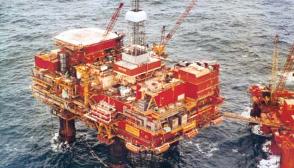
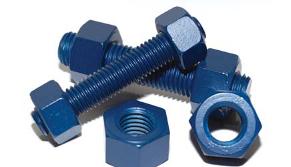
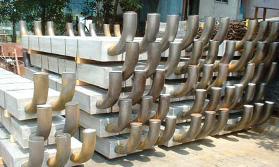
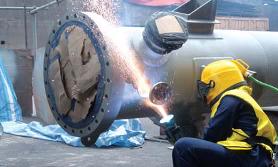

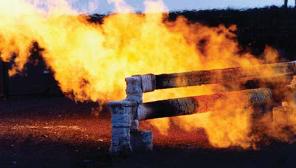
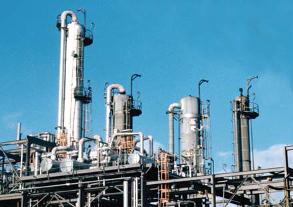
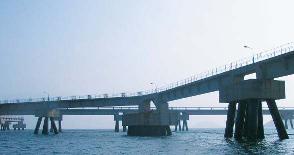


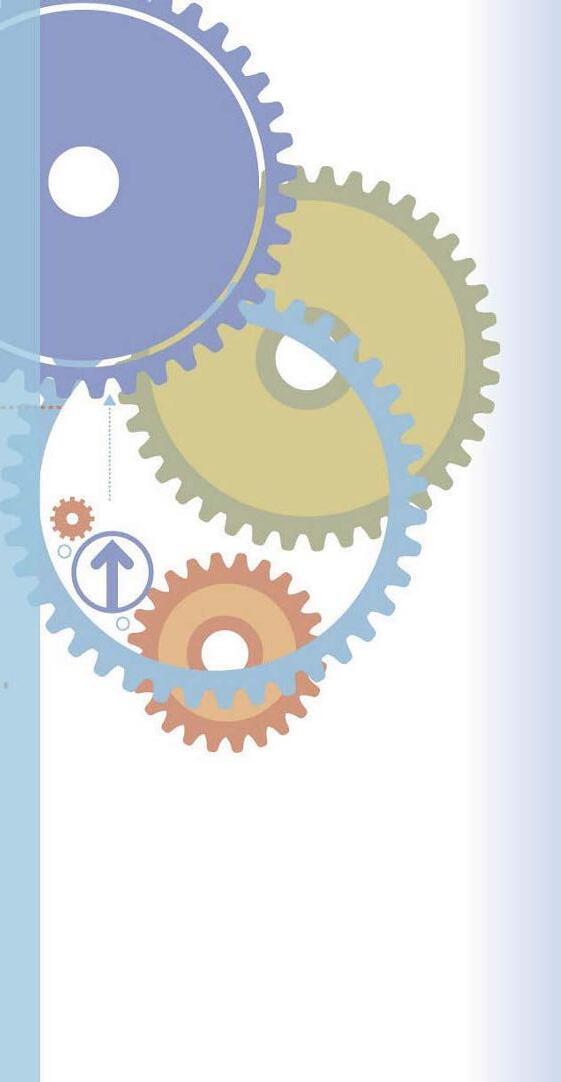
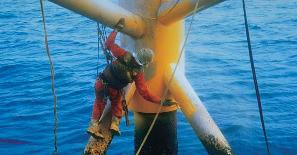

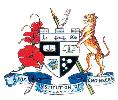
Circulaion and Readership Proile
Ouresteemedreadershipconsistsofceriiedengineers,decision makingcorporateleaders,CEOs,governmentoicials,project directors, entrepreneurs, project consultants, engineering consuling irms and companies involved with engineering products and services
JURUTERA iscirculatedtomorethan 30,000 registered members ofTheInsituionofEngineers,Malaysia(IEM),withan esimated readership of 120,000 professionals.
Adverising Beneits
Our business partners can be assured that their products and services will be given the circulaion and exposure it deserves, thus maintaining a sustained adverising presence to our core readers of decision-making engineers and technical experts. Our website ofers an even wider market reach, with added internaional presence, aided by our internaional ailiaion with oicial engineering bodies all over the world. Our online and oline adverising features such as banner adverising,ariclesponsorshipanddirecte-mailannouncements haveproventobesuccessfulmarkeingstrategiesthatwillsetthe businesses of our partners apart from their compeiion.
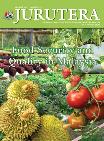
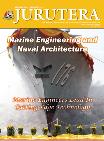
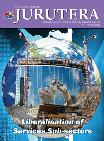
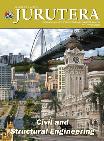


will be exposed to the risk of crashing during take-off and landing. Cars may be displaced by the force of downburst winds. Downburst winds are usually formed when high pressure air systems of downdrafts begin to sink and displace the air masses below it, because of their higher density. When these downdrafts reach the surface, they spread out and turn into destructive straight-horizontal winds.
The conditions for generation of severe thunderstorms are [Ref. 4]:
• Water vapour in the atmosphere at low levels, i.e. high humidity
• Instability in the atmosphere, i.e. a negative temperature gradient with height greater than the adiabatic rate of the neutral atmosphere
• A lifting mechanism that promotes the initial rapid convection – this may be, for example, in the form of a mountain range or a cold front.
1.4 wiNd pROfiliNg ThuNdERsTORm
The wind proile for thunderstorm [Ref. 4] can be represented as follows:

r = the radial coordinate from the centre of the downburst
R = the characteristic radius of the downburst shaft
z = the height above ground level
c = a characteristic height out of the boundary layer
k = a characteristic height in the boundary layer
λ = a scaling factor, with dimensions of [time]-1
From simple mathematical calculus, the maximum wind velocity U occurs at r = 1.075 R. (Note: In Holmes’ postulation, the maximumvalueoccursatr=1.121R).TheirsttwotermsinEquation 1 relate to the distance from the centre, while the third term relates to the vertical wind proile. The maximum horizontal wind velocity usually occurs at 50-100 m above the ground level.
The wind proile sketch shown in the following Figure 2, for = 75 m/s, is an arbitrary value for comparison purposes. Further research and site measurement are needed to determine the actual value for λ, c and k.
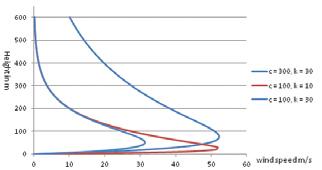
2.0 CuRRENT wiNd dEsigN pRaCTiCE iN malaysia
Local structural engineers are expected to refer to MS1553:2002 [Ref.1] to ascertain the design wind speed which, in turn, will lead to a design wind pressure to be applied as wind loading or actions against building structures. This standard is an adoption of the previous Australian and New Zealand Standard AS1170.2 – 2002 on wind loads.
The wind proile adopted by MS 1553: 2002 is based on power law and is reproduced as follows (in Figure 3):
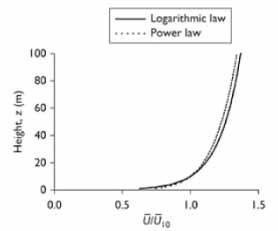
From Figure 3, we can see that the two relationships are extremely close, and that the power law is quite adequate for engineering purposes.
As discussed above, thunderstorm wind is actually very frequent in Malaysia. By comparing the two sets of the wind proile, that suggested by MS 1553 tends to underestimate the wind effect by up to about 100 m. This will cause problems to low-rise buildings and structures such as billboards or advertisement monopoles. In fact, this was captured by the Thailand wind code, where an additional factor was adopted for advertisement billboard design.
Statistical analysis for MS 1553 was carried out based on the speed of wind, whereas in BS 6399, EN1991-1-4 and Hong Kong wind code, the statistical analysis was carried out for the square of the speed, v2
Furthermore, in MS 1553, only up to a 100-year return period wind speed was quoted. No further information was revealed in the code for the higher return periods. It was also noticed that the statistical analysis was carried out station by station. This will affect the computation of the statistical factor cprop, where every station may have to adopt different igures.
At the moment, the Malaysian Standard is up for a review and changes are expected, not only in putting in the necessary amendments in line with various changes made to the latest revision of AS1170.2, but also the basic wind speeds as presented for the various wind speed stations. All three authors of this paper are members of the reviewing Technical Committee looking into amending MS1553:2002.
3.0 QuEsTiON Of REliabiliTy aNd aCCEpTabiliTy Of wiNd spEEds RECORdEd
A working group was formed to look into the accuracy and reliability of wind speed records and how the data can be collated and analysed, so as to produce a distribution of extreme wind speeds which can be relied on for structural design purposes.
Characteristics of the wind – random – in terms of co-relation (linear regression), the trend line should be near horizontal (i.e. the phenomena is consistent throughout the period of study) and R2 should be practically zero (i.e. to show that the process is actually random). These two criteria are used to check the reliability of the recorded wind speed data.
For some stations, the gradient of the trend lines were negative. By checking on development in the vicinity of a station, it was found
Eqn.(1)
Figure 2: Proile of horizontal wind velocity during a stationary downburst
Figure 3: Comparison of the logarithmic and power laws for mean velocity proile Source: John Holmes [Ref. 4]

AUTODESK BUILDING INFORMATION MODELLING (BIM) SYSTEM TRAINING
"BIM - Transforming the Construction Industry"
disCOVER bim: a bETTER way TO build bETTER buildiNgs
Building Information Modelling (BIM) offers a novel approach to design, construction, and facility management in which a digital representation of the building process is used to facilitate the exchange and interoperability of information in digital format. BIM is beginning to change the way buildings look, the way they function, and the ways in which they are designed and built.
KLIA Professional and Management College, being the premier in Construction, now offers the most comprehensive BIM Training in Malaysia to AEC industry players.
introduction to bim (1/2days)
bim for Technician (2days)
bim for modeler (architecture) (3days)
specialised autodesk Revit structure/architecture/mEp (5days)
bim for modeler (structure) (3days)
bim for modeler (mEp) (3days)
bim for Coordinator (3days)
bim for manager (2days)
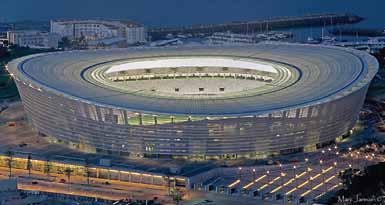
ExECuTiVE masTER iN OCCupaTiONal, safETy & hEalTh
In collaboration with Universiti Teknologi Malaysia (UTM)
ExECuTiVE diplOma iN OCCupaTiONal, safETy & hEalTh
In collaboration with Universiti Teknologi Malaysia (UTM)
spECialisEd iN pROJECT maNagEmENT
spECialisEd iN OCCupaTiONal, safETy aNd hEalTh
spECialisEd iN aiRpORT plaNNiNg & dEsigN
CEp - duTyhOldER's ObligaTiONs uNdER ThE Osh lEgislaTiON COsTs aNd EffECTs Of wORkplaCE aCCidENTs
CEp - hiRaRC (adVaNCEd) (ThE hOw)
CEp - sCaffOldiNg
CEp - wORkiNg aT hEighT
CEp - CRaNE OpERaTiON
CEp - fORmwORk & falsEwORk
CEp - accident investigation & Notification
CEp - managing Osh pre-Construction (Contract management)
For registration please log on to www.kliacollege.edu.my
Further info, please call: Lela/Fakri at 603-8783 1002/1006 Email: lela@kliacs.com.my / fakri@kliacs.com.my Course will be conducted at KLIA Professional & Management College
that when the area changed from open space to developed area, the wind speed recorded was eventually reduced over the study period and some stations showed changes in measuring equipment as well as change in location. Hence, suitable adjustment had to be carried out to ensure that the data collected satisied the consistency and random conditions.
4.0 basis Of sTudy iNTO ExTREmE pRObabiliTy aNalysis Of RECORdEd wiNd spEEd daTa
A primary purpose in plotting a set of ordered observations on probability paper is to simplify the inspection of their distribution. Normally, Gumbel Type 1 distribution will be used for the return period analysis. There are a few ways to estimate the probability of exceedance. First of all, we need to arrange the annual extreme in ascending sequence. In general, the probability of exceedance can be estimated by:
Equation (2) is valid for k-values not more than 0.5, where n is the ranking of the data and N is the total number of data. Typical values selected for a = 0, 0.44 and 0.5. Gumbel distribution is deined as follows:

The parameters α and u will be estimated based on two different methods, i.e. linear regression and maximum likelihood method.
Return period analysis was carried out for data collected from a total of 34 wind stations for both v and calculated v2. Data from a total of 37 wind stations were collected as shown in Table 1. If the available data is more than 30, then it is deemed to be acceptable. If the number of data lies between 25 and 29, it is classiied as slightly insuficient. Should it fall between 15 and 24, it is classiied as insuficient. If the number of data is less than 15, then it will be discarded. The analysis will be carried out on valid data from all relevant wind stations except those classiied as discarded.
When the consistency analysis was carried out, the details of station classiication were used. The harmonisation of collected data was applied to all stations to ascertain the probability factor. A common consensus was established since the calculated wind pressure is a function of squared velocity (v2). In turn, the return period analysis should also be carried out using the same velocity function to v2 instead of v. The basic wind speed based on v2 is shown in Table 1. Likewise, the K-factor in the probability factor is also shown in Table 1.
The probability factor, cprop which is deined as stated in EN19911-4 [Ref. 5]:

Both BS 6399 and EN1991-1-4 recommended that the value of K to be 0.2 and n to be 0.5. The value n = 0.5 corresponds with the analysis performed on v2. The values of K-factors for various stations were shown in Table 1. The average value for K was 0.305. It will be the committee’s responsibility to determine this Nationally Determined Parameter (NDP) for MS EN 1991-1-4. Figure 4 below shows the comparison of the value of probability factor, cprop corresponding to K = 0.305 and K = 0.2.
Eqn.(2)
Eqn.(6)
Eqn.(3)
Eqn.(4)
Eqn.(5)
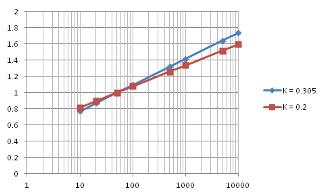
5.0 OuTCOmE Of daTa aNalysis fOR VaRiOus wiNd sTaTiONs
5.1 iNTERpRETaTiON Of REsulTs ObTaiNEd
Thunderstorm wind had not been considered in a logical approach in the previous Malaysian Standard MS1553:2002. The analysis of the collated reliable wind speed data from 34 out of 37 wind stations in Malaysia showed that Kuching in Sarawak has a top wind speed of 35.52 m/s compared to Ipoh which has a recommended wind speed of 35.18 m/s. The previous MS 1553 did not include Sabah and Sarawak in wind speeds of towns/locations there.
The lowest wind speed recommended was 22.28 m/s for Lubuk Merbau, Terengganu, with average wind speed of 29.13 m/s for the country as a whole. In terms of reliability, the K value ranged from a high of 0.63 to a low of 0.18, while the average K was 0.305. The Technical Committee may or may not take the average as the NDP for MS EN1991-1-4.
These results were set to a 3-sec gust wind speed measurement. When the Technical Committee recommends a switchover from
24Melaka,Melaka45Acceptable25.640.266 25Mersing,Johor45Acceptable34.000.363 26Miri,Sarawak45Acceptable29.000.272
27 MuadzamShah, Pahang 28 Slightly insuficient 25.670.325
28 PetalingJaya, Selangor 40Acceptable30.080.285 29Sandakan,Sabah45Acceptable26.000.229 30Senai,Johor 37Acceptable30.860.283 31Sepang,Selangor 13Discarded 32Sibu,Sarawak 45Acceptable30.080.241 33Setiawan,Perak 45Acceptable28.390.273
34 SriAman, Sarawak 28 Slightly insuficient 30.800.286 35Subang,Selangor 45Acceptable31.570.399 36Tawau,Sabah 32Acceptable28.880.263
37Temerloh,Pahang33Acceptable35.520.235
2.990.093
MS1553:2002 to MS EN1991-1-4, then a 10-min averaging wind speed will be used in place of the conventional 3-sec gust wind speed, which is more suited to thunderstorm winds. A scaling factor will have to be applied then. This needs further work to be carried out by the IEM Technical Committee on Wind Code.
6.0 CONClusiON
Based on the discussion above, the following factors shall be taken into consideration for the future Malaysian wind code: i. Type of wind – the effect of tropical thunderstorm wind shall be considered, especially for medium and low rise structures. ii. Basic wind speed computation – to adopt the square of the wind speed instead of wind speed iii. K value –this factor will affect the reliability of the wind code and requires the Technical Committee to recommend the appropriate Nationally Determined Parameters (NDP) for the MS EN19911-4.
REFEREncEs
[1] “MS 1553 : 2002 – Code of Practice on Wind Load for Building Structure”, Department of Standards Malaysia, 2002, 95p.
[2] Gringorten, I. I. (1963), A Plotting Rule for Extreme Probability Paper, J. Geophys. Res., 68(3), 813–814.
[3] http://en.wikipedia.org/wiki/Thunderstorms
[4] Holmes, J. D., “Wind Loading Structures”, 2nd Ed, Taylor & Francis, 2007, 444p.
[5] “BS EN1991 Part 1-1-4: General actions.Actions on structures, WindActions”, BSI, 2005, 146p.
Ir. prof. Dr Jeffrey chiang is currently Honorary Treasurer of IEM. He has previously served as Honorary Secretary of IEM and is still serving as a member of IEM Technical Division of Civil & Structural Engineering, and as Chairman of IEM Technical Committee on Earthquake. He is also the Dean of Faculty of Engineering & Built Environment at SEGi University, Kota Damansara Campus.
Ir. Tu Yong Eng is a professional engineer and amateur mathematician. He has extensive experience in civil and structural, design and construction. He has been continually involved in education and research, participating and organising various courses, seminars and conference. He was a member of various technical committees which drafted several Malaysian Standards. He was also an advisor to several local colleges and universities.
preview of national Annex to Ec8: seismic loadings for peninsular Malaysia, sabah and sarawak

iNTROduCTiON
In April 2013, a technical paper entitled, Recommended Earthquake Loading Model For Peninsular Malaysia was published in IEM Jurutera. This was followed by a publication in IStructE Conference 2013 (held in Beijing and Shanghai) under the title Earthquake Loading Model In The Proposed National Annex To Eurocode8 For Peninsular Malaysia, both of which were presented by Professor Nelson Lam (refer to Figure 1).
In both papers, the Preliminary Hybrid Seismic Response Spectrum Model for Peninsular Malaysia was presented internationally for the irst time.
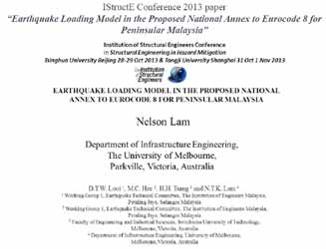
From the April 2013 IEM workshop on earthquake and the two technical papers published in 2013, the following are the key points to note:
1. The use of 2,500-year return period and displacement based approach for seismic analysis.
2. One uniied standardised seismic response spectrum model developed for the whole peninsula.
3. Two-tier site factor approach to account for local conditions.
In the IEM workshop on “2-day Workshop on Recommended Earthquake Loading Model in the Proposed National Annex to Euro Code 8 for Sabah, Sarawak & Updated Model for Peninsular Malaysia”, held on 16th-17th
July, 2014, the updated preliminary design spectrum for Peninsular Malaysia, and a newly established preliminary design spectrum for Sabah and Sarawak were introduced.
The report gave a brief introduction into the three response spectra mentioned above, for a return period of 2,500 years of seismic wave transmission at bedrock level.
pENiNsulaR malaysia
For the distant earthquake model, the Uniform Hazard Spectrum (UHS) developed by Pappin et al (2011) was modulated to incorporate the latest updates of Ground Motion Prediction Models. For the local earthquake, a deterministic design scenario of M6 at R=20km, based on global hazard model was recommended, reconciling with the world average of intraplate earthquakes for a return period of 2,500 years.
The updated model was revised from the proposed 2013 Design Spectrum Model for Peninsular Malaysia to cater for better understanding of local intraplate earthquakes and modulated corner periods. Combining both distant and local hazards, the updated model was presented in both displacement-based and force-based formats, and expressed algebraically. in a manner similar to EC8 peak ground acceleration format.
Figure 2a below is the displacement spectra, and igure 2b is the acceleration spectra. From the igures, up to period of 2s, the spectra is controlled by the local earthquake, after 2s the distant earthquake controls.
saRawak
With reference to Kuching, Sarawak, earthquakes of magnitude 3.5Mb to 5.3Mb have occurred within 500 km from Kuching. There are some major faults in the State, including the Kelwait Fault and Bukit Masing Fault (Figure 3).
A single uniied response spectrum for Sarawak is recommended, using the same principle as that for the updated model for Peninsular Malaysia, such that the local and distant models are regulated using the displacement format (Figure 4a) and presented both in displacement and EC8 peak ground acceleration format (Figure 4b). As seen in the igure, the design spectrum for Sarawak is controlled by the local earthquakes.
by Ir. Prof. M. C. Hee
Figure 1: Front cover of IstructE Conference 2013 paper
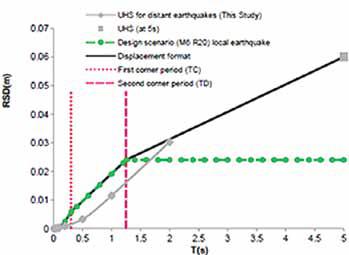
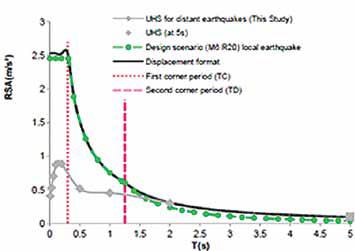
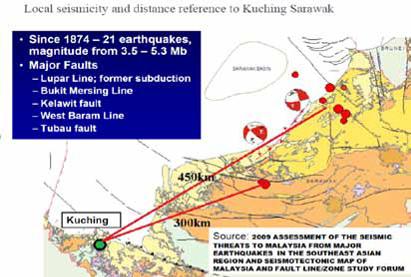
Since Sabah is very near highly volatile, earthquake-prone countries such as Indonesia and Philippines, the chances of an earthquake happening there cannot be taken lightly or overruled. In the past, earthquakes of magnitude greater than 5 have been recorded at a distance of approximately

sabah
Figure 2a: Displacement format of Design Spectrum model for Peninsular Malaysia
Figure 3: Kuching Reference Distance to fault zones
Figure 2b: EC8 peak ground acceleration format Design Spectrum model for Peninsular Malaysia



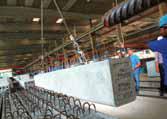
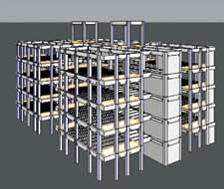
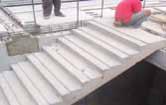



sales & marketing Office: 3rdFloor,WismaChineseChamber, 258JalanAmpang, 50450KualaLumpur
Tel +60(3)42510216
Fax +60(3)42510329
Website www.precastpsb.com.my
Email enquiries@precastpsb.com.my
factory:
Lot6704,KawasanPerindustrian TuankuJaafarSenawang
71450SerembanNegeriSembilan,Malaysia
Tel +60(6)6781037/0233
Fax +60(6)6786257
Website www.precastpsb.com.my
Email enquiries@precastpsb.com.my
100 km from Sabah (Figure 5). Hence a uniied design model for the whole of Sabah was recommended (Figure 6a/b), similar to that for Peninsular Malaysia and Sarawak.
pRElimiNaRy COsTiNg
Preliminary structural cost implication due to the proposed Hybrid Design Spectrum was carried out on structures of rigid-jointed frame for 1-storey and 5-storey buildings, shear wall-frame for 10-storey and cored-wall for 30-storey buildings.
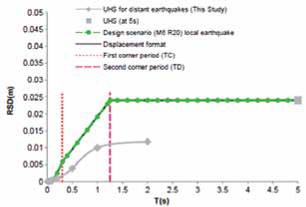
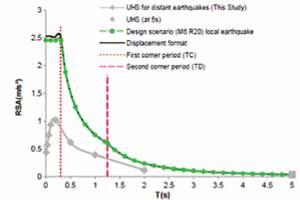
Refer to the IEM “2-day Workshop on Recommended Earthquake Loading Model in the Proposed NationalAnnex to Euro Code 8 for Sabah, Sarawak & Updated Model for Peninsular Malaysia”,16th-17th July, 2014 lecture notes for further details in the costing.
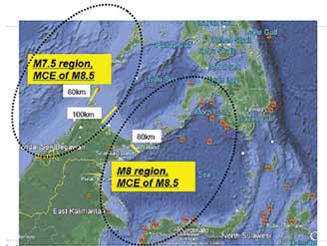
Figure 5: Sabah Reference Distance to fault zones
Figure 4a: Displacement format of Design Spectrum model for Sarawak
Figure 4b: EC8 peak ground acceleration format Design Spectrum model for Sarawak
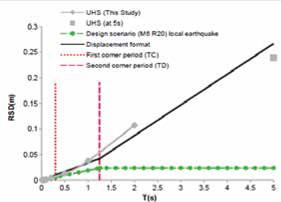
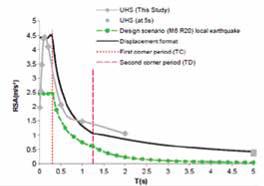
RECOmmENdaTiON
Therecommendedearthquakedesignspectrumspresented at the workshop are as summarised below in Table 1.
Table 1. Parameters for Hybrid Design Spectrum for P. Malaysia, Sabah, Sarawak
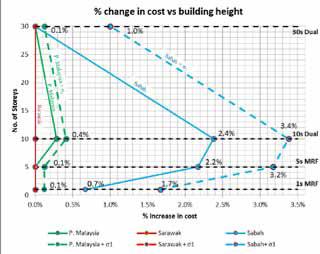
Refer to the IEM “2-day Workshop on Recommended Earthquake Loading Model in the Proposed National Annex to Euro Code 8 for Sabah, Sarawak & Updated Model for Peninsular Malaysia”,16th-17th July, 2014 lecture notes for further details.
CONClusiON
It can be concluded that:
Hybrid Design Response Spectrum for Peninsular Malaysia is a combination of short and long distant earthquake with a peak ground acceleration of 0.1g for a return period of 2500 years at bedrock level.
1. Hybrid Design Response Spectrum for Sarawak is dominated by local earthquake with a peak ground acceleration of 0.1g for a return period of 2,500 years at bedrock level.
2. Hybrid Design Response Spectrum for Sabah is dominated by long distant earthquake with a peak ground acceleration of 0.18g for a return period of 2,500 years at bedrock level.
3. Preliminary structural cost increase (excluding foundation) is only 3.4% for a 10-storey building.
REFEREncEs
[1] Lam, N.T.K., Hee, M.C., Tsang, H.H. &Looi, T.W.“Recommended Earthquake Loading Model for Peninsular Malaysia”,IEMJurutera, April 2013.
[2] Pappin, J.W., Yim, P.H.I., Koo, C.H.R., “An Approach for Seismic Design in Malaysia Following the Principles of Eurocode 8”, IEM Jurutera, October 2011.
[3] Looi, T.W., Hee, M.C., Tsang, H.H. and Lam, N.T.K., “Earthquake Loading Model in the Proposed National Annex to Eurocode 8 for Peninsular Malaysia”, IStructE Conference 2013, Beijing (28-29 Oct. 2013) and Shanghai (31 Oct – 1 Nov 2013).
[4] The Institution of Engineers of Malaysia, “2-day Workshop on Recommended Earthquake Loading Model in the Proposed National Annex to Euro Code 8 for Sabah, Sarawak & Updated Model for Peninsular Malaysia”, Workshop Lecture Notes, KL, 16th-17thJuly, 2014.
Pengumuman yang ke-74
sEnARAI pEnDERMA KEpADA WIsMA DAnA bAngUnAn IEM
Insitusi mengucapkan terima kasih kepada semua yang telah memberikan sumbangan kepada tabung Bangunan Wisma IEM. Ahli-ahli IEM dan pembaca yang ingin memberikan sumbangan boleh berbuat demikian dengan memuat turun borang di laman web IEM htp://www.iem.org.my atau menghubungi secretariat di +603-7968 4001/5518 untuk maklum,at lanjut. Senarai penyumbang untuk bulan September 2014 adalah seperi jadual di bawah:
no.no. AhlI nAMA
512569EWEDY BACHI
Ir. prof. M.c. hee is a member of IEM TechnicalCommittee on Earthquake, Working Group 1 Chairman, Study on Peak Ground Acceleration and Response Spectrum for Malaysia. no.no. AhlI nAMA 119947ABDOL SALAM BIN NS MOHAMED SARIFF
ABDULLAH BIN ABDUL RAHMAN
314771 AMBROS A/L FRANCIS GEORGE
424817AMIRUL ZIZI BIN UDA NOOR ABDUL KARIM
641283MOHAMAD FARIZ BIN MOHAMED NASIR
710855 SHAHAR BIN ABDULLAH
855870 VIMALAN NAMBIER A/L VIJIYAN
Figure 6a: Displacement format of Design Spectrum model for Sabah
Figure 6b: EC8 peak ground acceleration format Design Spectrum model for Sabah












Civil, Geotechnical, Hydraulic, Marine and Landfill Engineering

Soil Stabilization, Earthworks, Erosion Control





Slope Repair
half-dayseminar on“Impactof structural Eurocodeson steelandcomposite steel-concrete structures”

ThE Civil and Structural Engineering Technical Division (CSETD) of IEM and Hiap Teck Venture Berhad (HTVB) Group of Companies jointly organised a half-day seminar titled Impact Of Structural Eurocodes On Steel and Composite-steel Concrete Structures.The seminar, sponsored by HTVB, was held at Sunway Resort Hotel on 22nd November 2013 and attended by 95 participants.
The speaker was Associate Professor Dr Chiew Sing-Ping, an expert on steel structures from the School Of Civil And Environmental Engineering, Nanyang Technological University, Singapore. He was also the Past President of the Singapore Structural Steel Society, former Council and Executive Member of the Institution of Engineers, Singapore and Vice-Chairman of the Joint Structural Division of the Institution of Structural Engineers.



Reinforced Soil Wall
Keystone Wall
Soft Soil Stabilization
River Bank Protection
Slope Erosion Control
Flood Mitigation
Coastal Protection
Silt & Sediment Control
Landfills
On-site Detention System
Earthworks
Infrastructures

Turf Reinforcement Matrix
Erosion Control Blanket
Coirlog & Straw Watters
Profix Sandfilled Mattress
Geocell / Geoweb
High Strength Geotextile
Nonwoven Geotextile
Polyester Geogrid
Geocomposite / Geofabric
Gabion & Gabion Mattress
HDPE Geomembrane
Geosynthetic Clay Liner
Chemilink
LANDASAN IMPIAN SDN BHD (CO. NO. 860015-T)
No 12-1 & 12-2, Jalan BPP 5/3, Pusat Bandar Putra Permai, 43300 Seri Kembangan, Selangor Darul Ehsan, Malaysia.
Tel: 03-8943 8598 Fax: 03-8943 8591
Design (Ching): 016-215 5531 Project (Teo): 016-233 5531
Email: landasanimpian@gmail.com
Dr Chiew started by talking about Structural Eurocodes which will be fully implemented and mandatory in Singapore by 1st April 2015. The two-year transition period started on 1st April 2013 and ends 31st March 2015 when both British Standard (BS) and Structural Eurocodes are acceptable in the city-state. He believes the implementation of Structural Eurocodes in Malaysia is underway and advisesdesignengineerstostartpreparingforthisassoonaspossible.
In the irst section of the seminar, Dr Chiew focused on the impact of Eurocode 3 (EC3) on steel structures design. A few design aspects coupled with working examples were highlighted, such as the residual stress due to the imperfections of materials, shear buckling for S460 steel, web bearing and web buckling. In the second section, he focused on the impact of Eurocode 4 (EC4), Composite Steel and Concrete Structures. He compared EC4 and BS in materials strength speciication. In composite structures, the resistance of headed shear stud connectors is generally lower in EC4 as compared to BS5950.
Dr Chiew also discussed the guidance for lateral-torsional buckling check for continuous composite beams and prototype testing and development of composite slab system using new proiled steel sheeting as per EC4.
In the Q & A session that followed, he took questions raised by the participants and the seminar ended at 1.00 p.m. CSETD representative Ir. Lo Seng Ling presented a memento and certiicate of appreciation to Dr Chiew. All participants were given a complimentary copy of Design Of Composite Steel And Concrete Structures With Worked Examples To Eurocode 4, which was authored by Dr Chiew and his colleague. The event continued with a factory visit to HTVB in Klang by 22 participants.
Ir. Dr ng soon ching is an Assistant Professor at Universiti Tunku Abdul Rahman (UTAR). He serves as a committee member in IEM Civil and Structural Engineering Technical Division.
by Ir. Dr Ng Soon Ching
cIVIl & sTRUcTURAl EngInEERIng TEchnIcAl DIVIsIon
Two-Day Course on “Simpliied-Uniied
Practical
Design to
MS EC0,
MS EC1 and Ms Ec2 from A consulting Engineer’s perspective”
CIVIL & STRUCTURAL ENGINEERING TEChNICAL DIVISIoN
ThE Civil & Structural Engineering Technical Division organised a two-day course on “Simpliied-Uniied Practical Design To MS EC0, MS EC1 and MS EC2 from a Consulting Engineer’s Perspective” on 17th-18th October 2013, at Armada Hotel in Petaling Jaya, Selangor.
The course instructor, Ir. M.C. Hee, is a Consulting Structural Engineer, Principal of MC Hee & Associates, committee member of the Civil and Structural Engineering Technical Division, and Adjunct Professor at University of Malaya.
The course attracted 95 participants, including consultant engineers, engineers from contracting irms, government agencies and local authorities, as well as faculty members from local institutions of higher learning. There were both young and experienced engineers in the audience. Ir. Ong Sang Woh chaired the session on the irst day, and Ir. Boone Lim chaired the session on the second day.
day ONE
Ir. Hee started with a lecture on the fundamentals of MS EC0: Basis Of Structural Design, by stressing on the coniguration, relationship and the scope of various Structural Eurocodes, as well as on the impact of Eurocodes for structural designers. Among the topics he covered were the terminologies used in Eurocodes, partial safety factors for loads and materials, fundamental load combinations for ULS and SLS conditions, examples of Ψ values for different load combinations, vertical and horizontal delection limits and the division of braced and unbraced frame structure for analysis. Various work examples were presented to enhance the participants’ understanding. Ir. Hee stressed that unlike conventional design codes which are descriptive in nature, the Eurocodes are performance based
Then, he deliberated on MS EC1: Actions on Structures, i.e. the loading code. The topics covered included classiications of actions and action categories with reference to the tables provided in the National Annex of EC1. Ir. Hee also presented examples of calculation for imposed loads reduction on beams and columns, with comparisons between the requirements of National Annex of EC1 and CP3 codes.
In the third lecture, he discussed the SLS requirements of durabilityandiredesignaccordingtoMSEC2aswellasthefactors causing durability loss in structural elements, code requirement for minimum concrete cover for various exposure classes (to meet durability requirements) and standard ire resistance.
Several practical examples were presented and comparison was made to the cover requirements in BS8110. Ir. Hee then talked about Design of RC Beams by using the “uniied approach” in accordance to MS EC2. Unlike the conventional approach of analysis and design of beams, the uniied approach utilises the factor of combined reinforcing index, q (as shown in Eq. 1), where the q factor can be used as a unifying parameter in the process of designing reinforced, pre-stressed and partially pre-stressed sections. The other topics discussed during this session included:

by Engr. Dr Sudharshan N.
• Type of beam failure and beam ductility
• Design of singly and doubly reinforced RC rectangular beams, design of T or L section beams
• Comparison of lexural capacity between BS8110 and EC2
Next he revisited the fundamentals of structural analysis. He strongly encouraged the use of manual check methods such as two-cycle moment distribution to acquire the feel of how structures behave under applied loadings by qualitative analysis in sketching the delected proile and the bending moment diagrams. Examples were shown to demonstrate the application of two-cycle moment distribution, in combination with the Principle of Virtual Displacement (PVD), to verify computer results and sketching the delection proiles of beams. He also covered the code coeficients for beam and one-way slab as provided in BS8110 and EC2 design codes, and the division of braced and unbraced frames during the analysis process.
The inal lecture dealt with the SLS requirement for delection and cracking. Among the topics discussed were the deemed-tocomply method, the K factors for structural systems, effective spanto-depth ratios and the practical applications of modiication factors for span-to-depth ratios.
day TwO
There were four main lectures today as follows:
1. Simpliied shear design to MS EC2
2. Design of RC columns in accordance to MS EC2
3. Design of plain and RC walls to MS EC2
4. Why we get it wrong sometimes.
Under the topic “shear design”, Ir. Hee covered the fundamentals of shear in beams, shear capacity of sections with and without reinforcements (longitudinal and shear), computations for web crushing approach and how to deal with concentrated loads located close to support.
Various worked examples comparing the shear design according to BS8110 and EC2 were presented during the lecture, and the question and answer session proved to be an enriching experience for the participants.
The second lecture was on the design of RC columns in accordance to EC2. Ir. Hee started with a discussion on column concrete cover requirement for ire and durability. He then covered the nuts and bolts related to the analysis and design of RC columns,
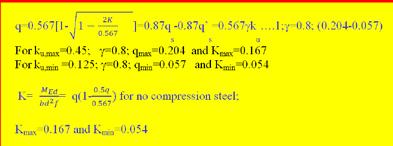
Raman, Grad. IEM

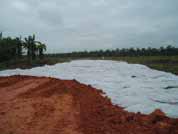


such as column rebar detailing, the computation of effective length and slenderness ratio of columns, the use of ISE Manual in the analysis and design of stocky and slender columns as well as L-shaped column design principles.
He also introduced the deinitive concept to distinguish whether a column was considered braced or unbraced, i.e. by using the ACI Commentary statement (as mentioned below) and the stability index of the frame. Many participants acknowledged that this was the irst time that they were introduced to a technique to deinitively “calculate the brace-ability of columns”. Several worked examples were also presented to reinforce the participants’ understanding of these concepts.
The speaker then invited Mr. Zuhal, his understudy, to demonstrate the use of a computer programme in the design computation for some examples presented in this session.
If Σkbracings> 6Σk columns, then the frames are braced, therefore the columns are also braced
The third lecture started with the structural classiication of walls and on the concrete cover requirement to meet ire resistance and durability needs. This was followed by a discussion on the various aspects related to the analysis and design of plain and RC walls.
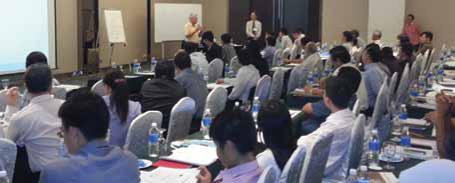
Some examples included braced or unbraced classiication of walls, effective length of plain walls, capacity of plain walls, capacity of stocky and slender RC walls, interaction diagram for RC core walls, etc.
Just as in the other sessions, Ir. Hee presented numerous practical examples to strengthen the participants’ understanding of the application of code requirements. In addition, demonstrations were carried out for the treatment of selected RC wall design problems with a computer programme.

To conclude the two-day session, the last slot was an interactive session between Ir. Hee and the participants on “Why we get it wrong sometimes?” Ir. Hee presented various cases of common errors that could be committed by an engineer, thus compromising the design, and then provided a guide on how these “errors” could be avoided.
The participants also took the opportunity to share some of the design and construction challenges they had encountered in their practice and to get the feedback from Ir. Hee.
In closing, Ir. Boone Lim thanked Ir. Hee for delivering such a comprehensive and valuable course. Then, on behalf of the organisers, he presented Ir. Hee with a token of appreciation.
Ir.Hee (right) receiving a token of appreciation from Ir. Boone Lim (left)
(1086519-T)
Ir. M.C. Hee speaking at the course
2-Day Workshop on “Recommended Earthquake loading Model
in The proposed national Annex (n.A.) to Ec8 for sabah, sarawak and update for peninsular
Malaysia”
ThE Civil and Structural Engineering Technical Division organised a 2-day workshop attended by 80 participants at Armada Hotel, Petaling Jaya, Selangor, on 16th & 17th July 2014. It was presented by Professor Nelson Lam (Professor and Reader, University of Melbourne), Ir. Professor M.C. Hee (Consulting Structural Engineer, WG1 IEM TC for EC8) and Engr. Daniel Looi T.W. (Ph.D. Candidate, University of Hong Kong, WG1 of IEM TC for EC8).
day 1
1.1. wORkshOp COmmENCEmENT
The Chairman of the Technical Committee (TC) for Earthquake Engineering in IEM, Prof. Ir. Dr Jeffrey Chiang, started with an introductory brieing into the work done by the committee for Earthquake Engineering in IEM. He briefed the participants on the background work, the structure of the committee, various working groups (WG) and the targeted completion of EC8 of the TC on Earthquake Engineering by IEM. The committee is responsible for studying the effects of Eurocode EC8 on reinforced concrete buildings in the event of an earthquake. Next, Encik Hassal Zamir, representing the Director of the Department of Standards (DSM), oficially opened the event and gave a short speech on the work and background of the department. The workshop was sponsored by the DSM.
1.2. baCkgROuNd sEismiCiTy Of lOCal iNTRaplaTE EaRThQuakEs
The irst presentation was delivered by Prof. Nelson Lam on the background seismicity of local intraplate earthquake, using land mass and occurrences of past earthquakes for 50 years, to arrive at the most appropriate predicted maximum of magnitude earthquake of M6 at a distance R of 20km.
He then demonstrated ground motion response predictions that lead to recommended design peak ground accelerations (pga) values for intraplate earthquakes. The maximum pga for 2,500-year Return Period at 0.1g (g is the acceleration due to gravity at 9.81m/s2) would be appropriate for Peninsular Malaysia. The effect of structures due to earthquake should be analysed and checked using all 3 types of Spectrum namely acceleration, velocity and displacement response spectrums.
1.3. RECOmmENdEd appROaChEs fOR mOdElliNg siTE EffECTs iN lOCal EaRThQuakE
After a short tea break and networking session, Prof. Lam delivered the second presentation titled “Recommended


approaches for modelling site effects in local earthquake”. He presented the approach to obtain the design spectrum for design of structures and explained the effects of soil ampliication and the importance of soil properties to achieve the response spectrum. He showed how various corners in the response spectrum were established and explained how the results were affected by soil properties and depth of soil. He strongly recommended that EC8 does not recommend a realistic value and one using the number, should take precautions on local soil effect. Natural period of the soil layer is the most important parameter in constructing the response spectrum for design. Prof. Lam also explained how to compute the natural period with the use of shear wave velocity and how to use the average shear wave velocities through layers of different soil with different soil properties.
1.4. updaTEd dEsigN spECTRum fOR pENiNsulaR malaysia
After lunch, Engr. Daniel Looi T.W. presented the Updated Design Spectrum for Peninsular Malaysia on bedrock for a Return Period of 2,500 years. Engr. Looi is currently pursuing his PhD in Hong Kong University on Earthquake Engineering. The main parts of the study on response spectrum due to far ield earthquake and local earthquake effect on structures in the peninsula was explained in detail in a technical paper published in the IEM Bulletin April 2013.The updated response spectrum using a Hybrid Modelling approach, which is a combination of local and distant earthquakes, was explained in detail and presented in both displacement based format and EC8 PGAformat. The updated version of the response spectrum will be published soon in the IEM Bulletin.
1.5. pRElimiNaRy COsT impliCaTiON fOR updaTEd dEsigN spECTRum fOR pENiNsulaR malaysia
Ir. Prof. M.C. Hee presented the indings for cost comparison between normal EC2 design for reinforced concrete and seismic design, using EC8 and the proposed Hybrid response spectrum for Peninsular Malaysia. He used examples for 1-storey, 5-storey, 10-storey and 30-storey reinforced concrete buildings (igure 1a to igure 1d respectively). The cost comparison presented was only for the structural components. The cost of inishes, M&E and foundation were not included. The increase in construction cost due to seismic design requirement according to EC8 and the proposed Hybrid response spectrum for Peninsula Malaysia may be minimal and insigniicant.
cIVIl & sTRUcTURAl EngInEERIng TEchnIcAl DIVIsIon
by Ir. Mun Kwai Peng and Ir. Dr Ooi Heong Beng (IEM TC for EC8)
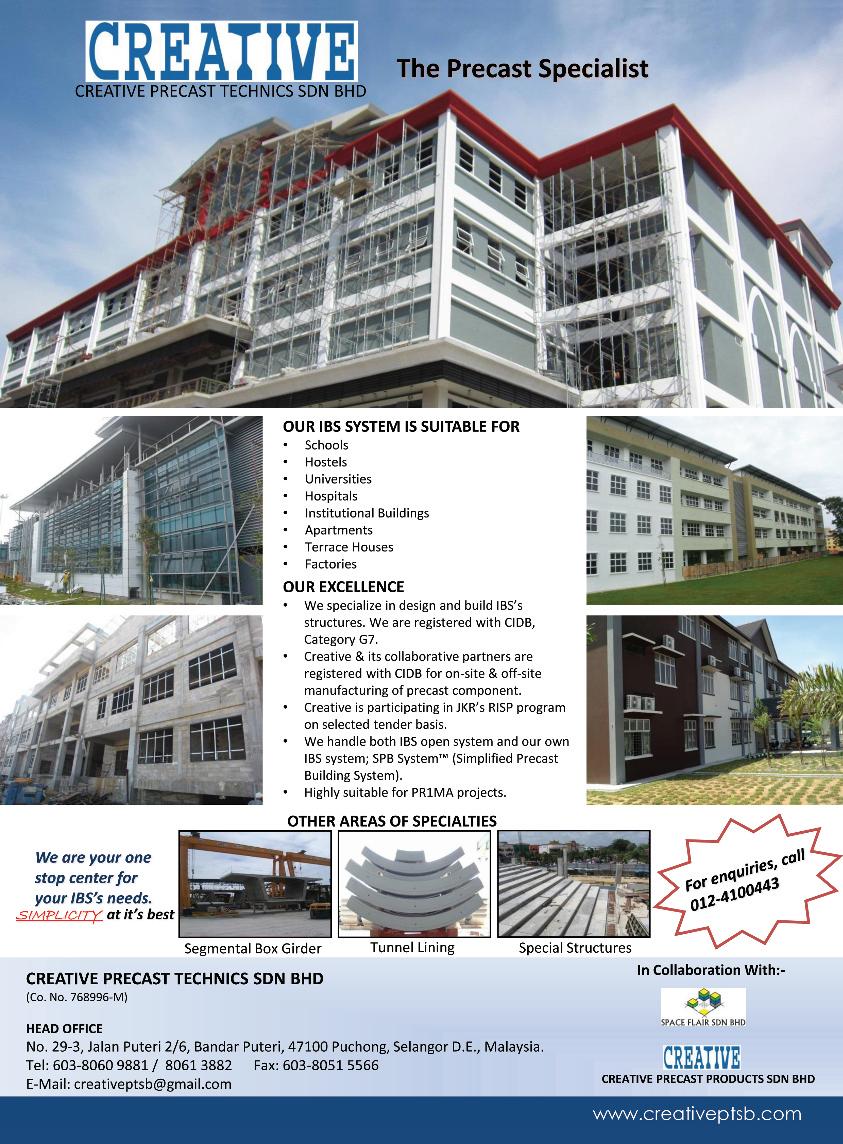
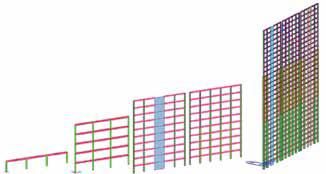
1.6. dEsigN spECTRum fOR pENiNsula saRawak
The last agenda of the day was delivered by Engr. Looi who presented the philosophy and concepts used to analyse the seismic effect in Sarawak, which was similar to that for the peninsula.
He presented the recommended Response Spectrum of Sarawak (at bedrock) in both displacement format and EC8 PGA (or spectral acceleration) format for a Return Period of 2,500 years.This was a single uniied seismological model across Sarawak (similar to the case in Peninsular Malaysia,with no Distance Factor).From this, he concluded that the response spectrum for Sarawak was controlled by local earthquake.
day 2
2.1 COsT impliCaTiON fOR dEsigN spECTRum fOR saRawak
Ir. Prof. Hee recapped what was discussed on the 1st Day:
a) The set of preliminary structural design of reinforced concrete buildings of height: a) 1-storey, b) 5-storey, c) 10-storey, and d) 30-storey, based on updated loading (action) model (Design Spectrum) for Peninsular Malaysia.
b) The structural layouts consist of rigid-jointed frame for 1-storey and 5-storey buildings, shear wall-frame for 10-storey and cored-wall for 30-storey buildings.
c) To model the non-linear behaviour of buildings under seismic action, in accordance with EC8-1, 4.3.1(7), the stiffness of the load bearing elements were evaluated, taking into account the effect of cracking. The elastic lexural and shear stiffness properties of concrete elements were taken to be one-half of the corresponding stiffness of uncracked elements.
d) Unit cost of construction adopted: Formwork at RM 40/m2, C30/37 Concrete at RM 300/m3 and Rebar at RM 3.5/kg. The Design Spectrum (DS) for Sarawak, as presented in Day One, was used to apply seismic actions on the 4 types of RC Buildings.
There was no cost increase of the design inclusive of earthquake action, compared with the design load combination without earthquake action. Load combination with imposed Notional Load (action) controlled the design.
A copy of the proceedings will be kept in the IEM Library. From his presentation, he concluded that for Sarawak, there was no increase in costing.
2.2. aN alTERNaTiVE sTaTiC mEThOd Of aNalysis Of buildiNgs
Prof. Lam presented a Quasi-static (Capacity spectrum) analysis method, assuming linear elastic behaviour of the building.
Lateral Force distribution of arbitrary amplitude is applied. Resulting delection distribution is calculated. The “effective” mass and stiffness can then be obtained to compute the fundamental natural frequency of the system (eq.2). If the
summaRy Of dEsigN basis designms ENEurocodeRemarks
Basis of Structural Design
MS EN 1990EC0
ActionsMS EN 1991-1-1
Wind Actions MS EN 1991-1-4
Wind EccentricityMS EN 1990, 3.5.8(P);
MS EN 1991-1-4, 7.1.2
Notional Load (action)
Reinforced Concrete Design
MS EN 1991-1-6, Annex A1, A1.3
MS EN 1992-1-1 EC2
Seismic DesignMS EN 1998-1
Seismic Action
EC1
EC1(Basic Wind Speed=20m/s, Terrain Category 4- City Areas)
EC0
EC1 (15% perpendicular to wind direction)
EC1Nominal Horizontal Forces
EC2
EC8
MS EN 1998-1 (National Annex)
EC8 NA Malaysia Annex, Hybrid DS Model_(IEM TC Proposed)
Seismic Eccentricity
MS EN 1998-1, 4.3.2
EC8(5% perpendicular to seismic direction)
applied force is νb on a structure with storey mass mi, producing a delection at each levelδj, the effective stiffness keff, and effective periodTeff can be calculated using the following formulas;

The results from this method were compared with those calculated using the EC8 (Annex B) procedure, which used the “equivalent” mass and stiffness approach.The resulting natural period only differs by less than 5%.
Figure 1aFigure 1bFigure 1cFigure 1d

ANCHOR-REINFORCED EARTH

Our Strength is Your Confidence
APPLICATION
Bridge Abutment
Land Reclaimation
Housing Development & Temporary Embankment
Other Civil Engineering Application
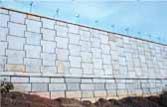
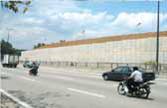

CT CRIBTM
APPLICATION
Slope Protection Embankment Stabilization
Housing & Road Project
Other Civil Engineering Application
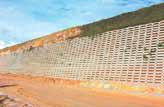
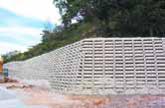
For enquiry please contact : cRIb TEchnologIEs sDn bhD (564096-A), ARE WAll (M) sDn bhD (542608-W) 46-A, SS 22/25, Damansara Jaya, 47400 Petaling Jaya, Malaysia
Tel: +603-7731 7391 Fax: +603-7725 7868
Email: groadesb@yahoo.com Website: http://www.ctsbare.com
He ended his presentation by extending the capacity spectrum analysis to inelastic behaviour. He showed the participants a quick and easy hand calculation method for generating the capacity spectrum via examples.
2.3. pRElimiNaRy RECOmmENdEd dEsigN spECTRum fOR sabah
Engr. Looi presented the recommended Response Spectrum of Sabah (at bedrock) in both, displacement format, and EC8 PGA (or spectral acceleration) format for Return Period of 2,500 years
This is a single uniied seismological model across Sabah (similar to the case in Peninsular Malaysia and Sarawak with no Distance Factor). This model had been veriied against Ground Motion Prediction Models for Long Distance Earthquakes developed by Megawati and Pan, from a catalogue of major long distance earthquakes.
This model had also been veriied against Jack Pappin’s UHS model, which was developed by ARUP, 2011 for long distance hazards (Return Period of 2,500years).
From the response spectrum presented, he concluded that the response spectrum for Sabah was controlled by distant earthquake.
2.4. pRElimiNaRy COsT impliCaTiON fOR dEsigN spECTRum fOR sabah
Adopting the same structural layout and cost data used for Peninsular Malaysia, Ir. Prof. Hee applied the proposed seismic DS Model action for Sabah to obtain the seismic design and quantities.
Similarly allowing for a 1% standard deviation of cost results, the structural design, including seismic action, had incurred a maximum cost increase of 3.4%, in comparison with non-seismic design.
2.5. displaCEmENT basEd mEThOd Of assEssmENT
Conventional seismic design is forced-based. However, the real behaviour of structure in a severe earthquake is related to material strains and structural stability, which are functions of displacement or out-of-plumb. Displacement as opposed to Force, is a more representative indicator of structural performance under seismic action. Prof. Lam began his presentation by explaining force calculation based design approach, deformation calculation based design and deformation speciication based approach. After that, he explained the importance of displacement based design and why it is preferred. He presented several case studies to illustrate such displacement-demand controlled failure modes.
The risks of overturning can be assessed accurately based on comparing Displacement Demand against Displacement Capacity.
“Size Effects” have been identiied as a controlling factor, and this cannot be captured by the conventional force-based procedure.
2.6. summaRy Of pRElimiNaRy COsT impliCaTiON
In the last presentation, Ir. Prof. Hee summarised the structural cost comparison for Reinforced Concrete Building Design of different heights (1-storey, 5-storey, 10-storey and 30-storey) with their prevailing respective type of construction (rigid frame, rigid frame, frame-shear wall, cored-wall) for the peninsula, Sarawak and Sabah. The seismic design was subject to proposed preliminary Hybrid DS Model action corresponding to their respective locations.
In his summary, Sabah DS (Design Spectrum) resulted in largest structural cost increase of 3.4%, compared with non-seismic design. Sarawak and Peninsular Malaysia DS did not result in signiicant cost increase by including seismic consideration in the design.
Note that the non-seismic structural design (based case) are all based on Eurocodes.
The set of British Standards for structural design (such as BS 8110, BS 5950) has been withdrawn by British Standards Institution since 31st March 2010.
2.7. OpEN fORum (This sEssiON was iNsERTEd pER REQuEsT Of uTm gROup Of REsEaRChERs)
An open forum was arranged for the end of the workshopto record discussions or dissent to the IEM TC Proposed Hybrid DS Model presented.
None of the participants raised objections to the recommended Earthquake Loading Model for Sabah, Sarawak and Updated Model for Peninsular Malaysia as presented in the workshop.
In the earlier workshop session, participants from UTM claimed that much work have been done by the UTM group of research workers. The fact is that hardly any peer-reviewed research result has been published or made available for comparison with the indings of IEM EC8 Malaysia Annex Technical Committee.
In the absence of dissent, the IEM Technical Committee will regard the Proposed Hybrid DS Model as having being endorsed by the workshop participants. This is in order to progress further towards inalising a Malaysia National Annex.
Prof. Lam stressed that it was very important that research results be peer-reviewed and published, so that they could be available for veriication and review by other researchers. Any deiciencies or defects could then be corrected and the results upgraded.
Ir. Mun Kwai peng is currently a member of the Technical Committee (TC) on Earthquake (Eurocode 8).
Ir. Dr ooi heong beng is presently anAssistant Professor in the Civil Engineering Department of Universiti Tunku Abdul Rahman. He graduated from University of Malaya in 1972 with BEng (Hons, 1st Class).After 3 years of compulsory service in JKR, he went to study MSc from University of London, a DIC (Concrete Structure and Technology) and PhD from Imperial College, London. He is a registered Professional Engineer with the Board of Engineers, Malaysia and Member of the Institution of Engineers, Malaysia and Institution of Structural Engineers, UK.
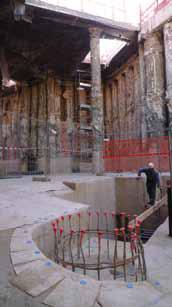
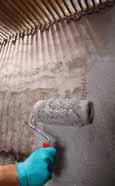
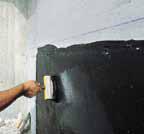
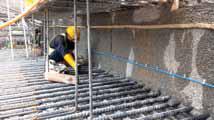
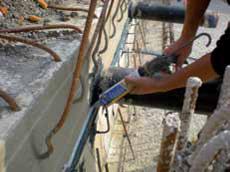
He began his career as a Bridge and Road Design Engineer with PWD (Malaysia) and later entered the private sector as Technical and R&D Manager in the piling industry and then progressed to Lead Civil / Structural Engineer in Ranhill Bersekutu before progressing to OGP Technical Services Sdn Bhd (a subsidiary of PETRONAS) and Ranhill Worley Sdn. Bhd.
He is presently a Member of the Technical Committee (TC) on Earthquake (Eurocode 8), Working Group 4 of TC Earthquake, Working Group 1 of TC Concrete (EC2) and participated in various conferences, seminars and workshops on Eurocodes.
IEM DIARY oF EVEnTs
Technical Talk: The Niched Role of Tracion Power System in the Electrical Power Engineering Profession for Malaysia’s Electric-based Railway Public Transportaion Infrastructure Projects
30th September 2014
Organisedby :ElectricalEngineeringTechnicalDivision Time :5.30p.m.–7.30p.m. Venue :WismaIEM
CPD/PDP: :2
Talk on Fixing of Fees by Professional Bodies under the Compeiion Act 2010 - Issues and Impact
19th September 2014
Organisedby :StandingCommiteebyProfessionalPracise Time :5.30p.m.–7.30p.m.
Venue :WismaIEM
CPD/PDP: :2
Kindly note that the scheduled events below are subject to change. Please visit the IEM website at www.myiem.org.my for more informaion on the upcoming events.
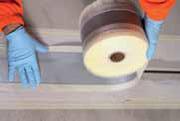

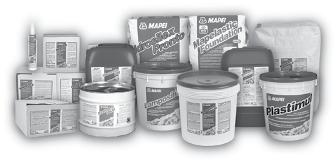












Tarikh:11Ogos2014
ToAllMembers,
sEnARAI cAlon-cAlon YAng lAYAK
MEnDUDUKI TEMUDUgA pRoFEsIonAl
TAhUn 2014
Berikut adalah senarai calon yang layak untuk menduduki TemudugaProfesionalbagitahun2014.
Mengikut Undang-Undang Kecil IEM, Seksyen 3.9, nama-nama seperi tersenarai berikut diterbitkan sebagai calon-calon yang layak untuk menjadi Ahli Insitusi, dengan syarat bahawa mereka lulusTemudugaProfesionaltahun2014.
Sekiranya terdapat Ahli Korporat yang mempunyai bantahan terhadap mana-mana calon yang didapai idak sesuai untuk menduduki Temuduga Profesional, surat bantahan boleh dikemukakan kepada Seiausaha Kehormat, IEM. Surat bantahan hendaklah dikemukakan sebulan dari tarikh penerbitan dikeluarkan.
Ir. gunasagaran Kristnan Seiausaha Kehormat, IEM, pERMohonAn bARU namaKelayakan
KEJURUTERAAn AERoAngKAsA
IZA IRYANI BINTI PAUZANBE HONS (UiTM) (CIVIL, 2009)
KEJURUTERAAn KoMpUTER & KoMUnIKAsI
NORHANA BINTI ARSAD BE HONS (UPM) (COMPUTER SYSTEM & COMMUNICATION, 2000) MSc (UPM) (COMMUNICATION & NETWORK, 2003)
KEJURUTERAAn ElEKTRIKAl
ABDUL YASIM BIN ALI BE HONS (UiTM) (ELECTRICAL, 2001)
ABU BAKAR BIN HASANBE HONS (UTM) (ELECTRICAL, 2010), MSc (CRANFIELD INSTITUTE OF TECH) (1984) PhD (UNITEN) (2013)
ARMAN BIN CHE OTHMANBE HONS (UTM) (ELECTRICAL, 2001)
LEE PAK FUBE (SOUTH AUSTRALIA) (ELECTRICAL & MECHATRONIC, 2001)
MARIANNE SHAMINI A/P
CHRISTOPHER GEORGE BE HONS(UNITEN) (ELECTRICAL & ELECTRONICS, 2005)
MGT. NASARUDDIN BIN MGT. MAZELAN BE HONS (UPM) (ELECTRICAL & ELECTRONICS, 2005)
MOHD FADLI BIN OTHAMANBE HONS (UiTM) (ELECTRICAL, 2006)
MOHD SYAHIR KYAIRI BIN AHMAD FUAD BE HONS (UKM) (ELECTRICAL & ELECTRONIC, 2005)
MUHAMAD HAFIS BIN SANURIBE HONS (UTM) (ELECTRICAL, 2007)
MUHAMMAD NASEER BIN ALIASME HONS (WALES) (ELECTRICAL & ELECTRONIC, 2008)
PARAMESWARY A/P ALAGAN BE HONS (UTM) (ELECTRICAL, 2002)
SHARIZAL BIN SHAMURI BE HONS (WALES) (ELECTRICAL & ELECTRONIC, 1997) MSc (STRATHCLYDE) (ELECTRICAL POWER WITH BUSINESS, 2004)
KEJURUTERAAn ElEKTRonIK
MOHD KHAIRUDDIN BIN MD ARSHADBE HONS (UTM) (MECHATRONICS, 1999) MSc (UKM) (ELECTRICAL, ELECTRONIC & SYSTEMS, 2005) PhD (LOUVAIN) (2013)
KEJURUTERAAn pEMbUATAn
KHAIRUDIN MOHAMEDBE HONS (UiTM) (MECHANICAL, 1995)
KEJURUTERAAn MEKAnIKAl
KAZREN JUSRI BIN ABDUL KARIMBE HONS (UTM) (MECHANICAL, 2003)
MAHADHIR B. MUSTAFFABE HONS (UTM) (MECHANICAL, 2000)
ROSLENDA BINTI HASAN BE HONS (UiTM) (MECHANICAL, 1999) MSc (UPM) (EMERGENCY RESPONSES & PLANNING, 2009)
ZULKEFLY BIN MOHD YUSOF BE HONS (UiTM) (MECHANICAL, 1999) MSc (UPM) (EMERGENCY RESPONSES & PLANNING, 2009)
KEJURUTERAAn ARKITEK nAVAl
YONG WU YUNG, DANIELBE HONS (LONDON) (NAVALARCHITECTURE & OCEAN, 1997)
KEJURUTERAAn TElEKoMUnIKAsI
YAN NAZIHA BINTI MD DALIBBE HONS (MULTIMEDIA) (ELECTRICAL, 2002) MSc (COLLEGE LONDON) (TELECOMMUNICATIONS, 2009)
pERpInDAhAn AhlI
no. Ahli namaKelayakan
KEJURUTERAAn KIMIA
38065 RIDHUAN AFFANDI BIN ABU BAKAR BE HONS (UPM) (CHEMICAL, 2007)
44580 ZAINAL BIN AHMAD BE HONS (SURREY) (CHEMICAL, 1998)
MSc (NEWCASTLE UPON TYNE) (2001)
PhD (NEWCASTLE UPON TYNE) (2005)
KEJURUTERAAn AWAM
49572CHAN HOOI SANBE HONS (UTM) (CIVIL, 2002)
24460 CHEE WENG YAN BE HONS (UTM) (CIVIL, 2003)
66756HASEEF IDZLAN BIN ZAHIDI BE HONS (UNISEL) (CIVIL, 2009) MSc (UiTM) (CIVIL, 2013)
19135 LIM THIAM POH BE HONS (UTM) (CIVIL, 2000)
29122MOHD FADLI BIN OSMANBE HONS (UPM) (CIVIL, 2003)
22126ONG SHENG HOWBE HONS (RMIT) (CIVIL, 2000)
54093PETRUS PHUI VUI KIUNBE HONS (CURTIN) (CIVIL & CONSTRUCTION, 2010)
27122 TEOH KEAN TEONG BE HONS (UMS) (CIVIL, 2005)
28219 WONG HOCK TEONG BE HONS (MALAYA) (CIVIL, 2007)
KEJURUTERAAn ElEKTRIKAl
58704ABU THALHAH B. MOHD LAZIMBE HONS (MALAYA) (ELECTRICAL, 2007)
49537 ENG TERNG GOANG BE HONS (MULTIMEDIA) (ELECTRICAL, 2010)
45347MAHESVARAN S/O SIBEPEREGASAM BE HONS (UNITEN) (ELECTRICAL POWER, 2009) ME (UNITEN) (2013)
49975PNG TIANG CHUN, FRANKIEBE HONS (CURTIN) (ELECTRICAL, 06)
49586TAN KHENG KWANG BE HONS (USM) (ELECTRICAL, 2009) MSc (USM) (ELECTRICAL & ELECTRONIC, 2012)
KEJURUTERAAn ElEKTRonIK
47548FAIZ BIN MOHD TURANBE HONS (UTM) (ELECTRICAL, 2010)
KEJURUTERAAn gEoTEKnIKAl
70629SHAH IZZNI TALIF BIN MOHD ADNAN BE HONS (QUEENSLAND) (CIVIL, 2007)
KEJURUTERAAn lEbUhRAYA
26496KANTHIMA NUINBE HONS (UNITEN) (CIVIL, 2005)
KEJURUTERAAn MEKAnIKAl
54510FAIT BIN HANAPIBE HONS (UiTM) (MECHANICAL, 2006)
41988MOHD ZIRWANDY BIN ZAINUDDIN BE HONS (UTM) (MECHANICAL-AERONAUTICS, 2003)
66462NOORAZIZI BIN MOHD SAMSUDDIN BE HONS (UTM) (MECHANICAL, 2007) ME (UTM) (MECHANICAL, 2011)
KEJURUTERAAn polIMER 41157MOHD BIJARIMI BIN MAT PIAHBE HONS (NORTH LONDON) (POLYMER, 1996) MBA (UKM) (2000), MSc (UiTM) (2005) PhD (UKM) (MATERIALS SCIENCE, 2014)
KEJURUTERAAn TElEKoMUnIKAsI 46771 CHUA MING YAM BE (HONS) (MMU) (ELECTRONIC, 2003) MSc (MMU) ( MASTER OF SCIENCE, 2007)
69489SITI NURBAYA MOHAMEDME HONS (IMPERIAL COLLEGE LONDON) (ELECTRICAL & ELECTRONIC, 2009)
IEM DIARY oF EVEnTs
one-Day course on Drilling Engineering overview 20th September 2014
Organisedby :Oil,GasandMiningTechnicalDivision
Time :8.30a.m.-5.00p.m.
Venue :WismaIEM
CPD/PDP: :6.5
Half Day Workshop on Principal Submiing Person (PSP) / Submiing Person (SP) to Adapt with OSC 3.0
20th September 2014
Organisedby :ConsulingEngineeringSpecialInterestGroupand SupportedbyKementerianPerumahanDanKerajaan Tempatan(KPKT)
Time :8.30a.m.–1.00p.m.
Venue :WismaIEM
CPD/PDP: :0
half Day Seminar on latest fire Safety Engineering Design and Best Industry Pracice (Postponed from 22 May 2014)
25th September 2014
Organisedby :YoungEngineersSecion
Time :9.00a.m.–1.00p.m.
Venue :WismaIEM
CPD/PDP: :3.5
Kindly note that the scheduled events below are subject to change. Please visit the IEM website at www.myiem.org.my for more informaion on the upcoming events.
Note: This is a coninuaion of the list which was irst published on page 46 of the August 2014 issue.
KEJURUTERAAn ElEKTRonIK
69946MACOUVER NG 1ST YEAR (UNIMAS) (MECHANICAL)
69947 MAJORIE TELUN AVIT 1ST YEAR (UNIMAS) (MECHANICAL)
69948 MAS ADILAH BT. MAHAMOOD AHAMAD 1ST YEAR (UNIMAS) (MECHANICAL)
69949MAS NOR ZAMIRLAH BT. ZAMIRHAN 1ST YEAR (UNIMAS) (MECHANICAL)
69875MASITAH BT. OSMAN 1ST YEAR (UTM) (MECHANICAL)
69876 MEGAVARNAN A/L MAHIVANAN 1ST YEAR (UTM) (MECHANICAL)
69657MIUHAMMAD BURHANUDDIN HELMI B. AZMI 1ST YEAR (UKM) (MECHANICAL)
69658 MOHAMAD AFIQ B. ZAINUDDIN 1ST YEAR (UKM) (MECHANICAL)
69659 MOHAMAD AMIRUL B. MOHAMAD ZAHIR 1ST YEAR (UKM) (MECHANICAL)
69660MOHAMAD FAIZ B. PATHURRAHMAN 1ST YEAR (UKM) (MECHANICAL)
69950MOHAMAD FARID B. A GHANI 1ST YEAR (UNIMAS) (MECHANICAL)
69877MOHAMAD KHAIRUL B. MOHD NOOR 2ND YEAR (UTM) (MECHANICAL)
69951MOHAMAD NAZRI B. HANG JEBAT 2ND YEAR (UNIMAS) (MECHANICAL)
69952MOHAMAD RIZQI IMTIYAZ B. GINDAR 1ST YEAR (UNIMAS) (MECHANICAL)
69953MOHAMAD RUSLI B. FARALI 1ST YEAR (UNIMAS) (MECHANICAL)
69661MOHAMAD ZULZAFRI B. MOHD KUSAINI 1ST YEAR (UKM) (MECHANICAL)
69954 MOHAMMAD AMIRUL FAIZ B. KALANA 1ST YEAR (UNIMAS) (MECHANICAL)
69955MOHAMMAD ISKANDAR ZULKARNAIN B. ROSLAN 1ST YEAR (UNIMAS) (MECHANICAL)
69956MOHAMMAD SYAFIQ B. MANAFFERY 1ST YEAR (UNIMAS) (MECHANICAL)
69662MOHAMMAD SYAHIRAN B. MANSOR 1ST YEAR (UKM) (MECHANICAL)
69957MOHAMMAD ZULHAFIZ B. JENUREN 1ST YEAR (UNIMAS) (MECHANICAL)
69958 MOHD ASYRAF B. ZAKARIA 1ST YEAR (UNIMAS) (MECHANICAL)
69959 MOHD AZRI B. AZIZI 1ST YEAR (UNIMAS) (MECHANICAL)
69960MOHD FARIQ AFA B. MATNOOR 1ST YEAR (UNIMAS) (MECHANICAL)
69961MOHD NIZAM B. IBRAHIM 1ST YEAR (UNIMAS) (MECHANICAL)
69962MOHD NURAMIN B. MASLI 1ST YEAR (UNIMAS) (MECHANICAL)
69963MOHD SHAUQI B. ISA 1ST YEAR (UNIMAS) (MECHANICAL)
69964MOHD SYZWAN ASQLANI B. AHIDI 1ST YEAR (UNIMAS) (MECHANICAL)
69965 MUHAMAD AMIRUL SHAFIQ B. ZAFRI 1ST YEAR (UNIMAS) (MECHANICAL)
69663 MUHAMAD AQIL B. AZRI 1ST YEAR (UKM) (MECHANICAL)
69966 MUHAMMAD ADLI DIAH B. AHMAD ZABIDI 1ST YEAR (UNIMAS) (MECHANICAL)
69967 MUHAMMAD AMMAR ASYRAF B. ZAINUDDIN 1ST YEAR (UNIMAS) (MECHANICAL)
69878MUHAMMAD FAIZ
HILMI B. MOKHTAR DIN 2ND YEAR (UTM) (MECHANICAL)
69664MUHAMMAD FIRDAUS B. KARIM @ KASIM 1ST YEAR (UKM) (MECHANICAL)
69968MUHAMMAD FIRDAUS B. SHAHAR 1ST YEAR (UNIMAS) (MECHANICAL)
69969MUHAMMAD FITRI B. MD RADZI 1ST YEAR (UNIMAS) (MECHANICAL)
69970MUHAMMAD HAFIZ B. MOHD HAJAD 1ST YEAR (UNIMAS) (MECHANICAL)
69665MUHAMMAD HAFIZ B. MOHD NOOR 1ST YEAR (UKM) (MECHANICAL)
69971MUHAMMAD HARMAINEY B. JASNIH 4TH YEAR (UNIMAS) (MECHANICAL)
69666MUHAMMAD HAZMAN B. MD ISA 1ST YEAR (UKM) (MECHANICAL)
69667MUHAMMAD IBRAHIM B. SAMSUDDIN 1ST YEAR (UKM) (MECHANICAL)
69972MUHAMMAD MAULA NORDIN 1ST YEAR (UNIMAS) (MECHANICAL)
69973MUHAMMAD NABIL B. HAS-BULLAH 1ST YEAR (UNIMAS) (MECHANICAL)
69974MUHAMMAD NAZIRUL B. HAMDAN 1ST YEAR (UNIMAS) (MECHANICAL)
69975MUHAMMAD NAZRIN B. SUFIYAN 1ST YEAR (UNIMAS) (MECHANICAL)
69976 MUHAMMAD TAUFIQIL HAFIZ B. MUSA 1ST YEAR (UNIMAS) (MECHANICAL)
69668MUHAMMAD ZAKI B. SHAHBANI 1ST YEAR (UKM) (MECHANICAL)
69977MUNIERAH BT. SAEE 4TH YEAR (UNIMAS) (MECHANICAL)
69677 MUSLIM B. ABDUL HAMID 4TH YEAR (PUO) (MECHANICAL)
69978 NADZRIN AHMED B. FASIHUDDIN 1ST YEAR (UNIMAS) (MECHANICAL)
69879 NARESH A/L SIVALINGAM 1ST YEAR (UTM) (MECHANICAL)
69979NAZRUL IRFAN B. ABDUL RAHMAN 1ST YEAR (UNIMAS) (MECHANICAL)
69980 NAZURAH BT. ANTUNI 1ST YEAR (UNIMAS) (MECHANICAL)
69880 NG YOUNG CHING1ST YEAR (UTM) (MECHANICAL)
69981 NOAMIE ANAK BALMI 1ST YEAR (UNIMAS) (MECHANICAL)
69669 NOOR ATIQAH BT. BADALUDDIN 1ST YEAR (UKM) (MECHANICAL)
69982NOOR JUWITA BT. JUNAIDI 1ST YEAR (UNIMAS) (MECHANICAL)
69881NOORHIZATHULAKMA BT. KHAMIS 1ST YEAR (UTM) (MECHANICAL)
69983 NOORULAQIDAH BT. SHAMSULUDA 1ST YEAR (UNIMAS) (MECHANICAL)
69984NOR UMIRAH BT. SUDIRMAN 1ST YEAR (UNIMAS) (MECHANICAL)
69985 NUR ADILAH BT. AHMAD 1ST YEAR (UNIMAS) (MECHANICAL)
69986NUR FARAH BT. ZAIN 1ST YEAR (UNIMAS) (MECHANICAL)
69670NUR FARAHHUDA BT. ZAINALABIDIN 4TH YEAR (UKM) (MECHANICAL)
69671NUR HAFIZAH BT. HABIDEEN 1ST YEAR (UKM) (MECHANICAL)
69672NUR HASDYANNA BT. HASNURASHID 1ST YEAR (UKM) (MECHANICAL)
69987NUR MEHRANIE BT. SHAMSUL BAHRI 1ST YEAR (UNIMAS) (MECHANICAL)
69882NUR NABILAH BT. MOHAMMAD MUSTAFA 1ST YEAR (UTM) (MECHANICAL)
69988NUR NADIA BT. HAMRI 1ST YEAR (UNIMAS) (MECHANICAL)
69989NUR SHARZAINA HANUM BT. SEKIUN 1ST YEAR (UNIMAS) (MECHANICAL)
69883 NUR'AN AMIERA BT. OMAR 1ST YEAR (UTM) (MECHANICAL)
69990 NURULADZATUL NADIA BT. ADZAHAR 1ST YEAR (UNIMAS) (MECHANICAL)
69884NURUL FAZIERA BT. FAIZUL RAHMAN 1ST YEAR (UTM) (MECHANICAL)
69885NURUL NADIA BT. MOHD IBRAHIM 1ST YEAR (UTM) (MECHANICAL)
69886NURULHUDA BT. TAJUDDIN 1ST YEAR (UTM) (MECHANICAL)
69887 OOI TZE XIONG2ND YEAR (UTM) (MECHANICAL)
69888PANG JACKSON 1ST YEAR (UTM) (MECHANICAL)
69991PATRICA DO WAN 1ST YEAR (UNIMAS) (MECHANICAL)
69992 PATRICIA IVY ANAK EDWIN AMIN 4TH YEAR (UNIMAS) (MECHANICAL)
69889 PERAVEEN A/L N KANNADHAS 1ST YEAR (UTM) (MECHANICAL)
69993PHILLIP MAPANG ANAK ANGKING 1ST YEAR (UNIMAS) (MECHANICAL)
69673RAJA SHARMIN IZZATY BT. RAJA LOB SHARUDDIN 1ST YEAR (UKM) (MECHANICAL)
69994 RAYMOND LUBUN ANAK TINSANG 4TH YEAR (UNIMAS) (MECHANICAL)
69995RIDHWAN B. BUSRAH 1ST YEAR (UNIMAS) (MECHANICAL)
69890SHALVEEN DAVE SINGH 1ST YEAR (UTM) (MECHANICAL)
69891 SHAZLIEN AINI BT. KAULANI 1ST YEAR (UTM) (MECHANICAL)
69996SHAZRUL NIZWAN B. SUHARDI 1ST YEAR (UNIMAS) (MECHANICAL)
69674SITI AISYAH BT. ISMAIL 1ST YEAR (UKM) (MECHANICAL)
69997SITI FARIS AFIFAH BT. ABDUL GHANI 1ST YEAR (UNIMAS) (MECHANICAL)
69998SITI FATIMAH BT. JASNI 1ST YEAR (UNIMAS) (MECHANICAL)
69999 STEVEN JOELANAK TOTAL 1ST YEAR (UNIMAS) (MECHANICAL)
69892 SYAFIQAH BT. AZMI 1ST YEAR (UTM) (MECHANICAL)
69893 SYAHIRAATIKAH BT. RAMLE 1ST YEAR (UTM) (MECHANICAL)
70000 SYLVIA WENDY ANAK BONEY 1ST YEAR (UNIMAS) (MECHANICAL)
69894 TAN MENG TECK1ST YEAR (UTM) (MECHANICAL)
69895TANG BING CHUONG, JACKY 1ST YEAR (UTM) (MECHANICAL)
70001 TANG KWONG YONG1ST YEAR (UNIMAS) (MECHANICAL)
70002TERENCE EMPURAI ANAK ANDAP 1ST YEAR (UNIMAS) (MECHANICAL)
70003THADDELIS SENABONG ANAK RENJAN 1ST YEAR (UNIMAS) (MECHANICAL)
70004 TIE TONG HENG, THOMAS 1ST YEAR (UNIMAS) (MECHANICAL)
70005 TIM BRANDON ANAK SAWING 1ST YEAR (UNIMAS) (MECHANICAL)
70006TING SING FUI 1ST YEAR (UNIMAS) (MECHANICAL)
69896TIONG JUANG LOONG 1ST YEAR (UTM) (MECHANICAL)
69897 VAIRASIVAM A/L KARISNA KUMAR 1ST YEAR (UTM) (MECHANICAL)
70007 VIGNESHWARAN A/L RAMRAO 1ST YEAR (UNIMAS) (MECHANICAL)
69649WILLIAM GRANETIN ANAK THOMAS 3RD YEAR (UTEM) (MECHANICAL)
69675WINSTON GERANG 2ND YEAR (UKM) (MECHANICAL)
70008WONG HA LEI, AMBROSE 1ST YEAR (UNIMAS) (MECHANICAL)
69898 WONG TING PHANG1ST YEAR (UTM) (MECHANICAL)
70009YASMIN SYAZWANI BT. MOHAMAD 1ST YEAR (UNIMAS) (MECHANICAL)
69899 YONG YUNG YIK1ST YEAR (UTM) (MECHANICAL)
69900 ZAFRUDDIN B. ABDUL AZIZ 1ST YEAR (UTM) (MECHANICAL)
70010ZARITH NAJWA BT. ZAIDI 1ST YEAR (UNIMAS) (MECHANICAL)
KEJURUTERAAn MEKATRonIK
69688 AHMAD THUFFAIL THASTHAKEER 1ST YEAR (MONASH) (MECHATRONICS)
69681AIKAAN NAJWA BT. MOHD MARZUDIN 1ST YEAR (UTEM) (MECHATRONICS)
69682 KAM FOONG YUAN1ST YEAR (UTEM) (MECHATRONICS)
69678KARTHIK SURIANDRAN A/L MATHAVAN 1ST YEAR (UTAR) (MECHATRONICS)
69683LOR SHENG QIN 1ST YEAR (UTEM) (MECHATRONICS)
69680 MOUATOVAADEL 1ST YEAR (APU) (MECHATRONICS)
69684 NURULAISHAH BT. ZAMSURI 1ST YEAR (UTEM) (MECHATRONICS)
69685 SITI AISYAH BT. ZAINAL 1ST YEAR (UTEM) (MECHATRONICS)
69686SITI NORBAIZURA BT. ABDULAZIZ 1ST YEAR (UTEM) (MECHATRONICS)
69689SULTAN EISSA EISSA SHWOK 1ST YEAR (MONASH) (MECHATRONICS)
69687TAN WEI CHIANG 1ST YEAR (UTEM) (MECHATRONICS)
69679TAN WEI CHOON 1ST YEAR (UTAR) (MECHATRONICS)
KEJURUTERAAn pEMbUATAn
69621AFIFAH ZAKIYYAH BT. JURI 1ST YEAR (UMP) (MANUFACTURING)
69622AMANINA SHARIDZAN BT. AZIZAN 1ST YEAR (UKM) (MANUFACTURING)
69623FARAH HAFIZAH BT. HAMKA 1ST YEAR (UKM) (MANUFACTURING)
69624FARLENA IDAYU BT. MD SALLEH 1ST YEAR (UKM) (MANUFACTURING)
69625ILYAS SYAFIQ B. OTHMAN 1ST YEAR (UKM) (MANUFACTURING)
69615KOH CHEE HAO 1ST YEAR (UTAR) (MANUFACTURING)
69616LEE HAOZHE 1ST YEAR (UTAR) (MANUFACTURING)
69617 LEE YI HEAN2ND YEAR (UTAR) (MANUFACTURING)
69618 MAH CHIA YI1ST YEAR (UTAR) (MANUFACTURING)
69626 MOHAMMAD AFIQ B. ABDUL RASHID 1ST YEAR (UKM) (MANUFACTURING)
69619MOHD FUAD B. UMAR 4TH YEAR (UTEM) (MANUFACTURING)
69627MOHD SYAMSUL AZWANI B. MOHD ABDULLAH 1ST YEAR (UKM) (MANUFACTURING)
69628MUHAMAD MUSTAQIM B. ANDUL LATIFF 1ST YEAR (UKM) (MANUFACTURING)
69629 MUHAMMAD ALIF B. JAMIAN 1ST YEAR (UKM) (MANUFACTURING)
69630 MUHAMMAD AMIRUL ASHRAFF B. IHAS 1ST YEAR (UKM) (MANUFACTURING)
69620 MUHAMMAD AZLAN B. MD AMIN 4TH YEAR (UTEM) (MANUFACTURING)
69631MUHAMMAD FAKHRUL RAZIE B. MAMAT 1ST YEAR (UKM) (MANUFACTURING)
69632MUHAMMAD NOOR FAHMY MAULA FAZARNOR 1ST YEAR (UKM) (MANUFACTURING)
69633MUHAMMAD SYAZANI FARHAN B. ZAINI 1ST YEAR (UKM) (MANUFACTURING)
69634NOOR FALHIAH BT. SAARI 1ST YEAR (UKM) (MANUFACTURING)
69635NORNISAADILA BT. MUSA 1ST YEAR (UKM) (MANUFACTURING)
69636NUR ANIS FASHA BT. ROSLAN 1ST YEAR (UKM) (MANUFACTURING)
69637NUR FATIHAH BT. ABDUL GHAFAR 1ST YEAR (UKM) (MANUFACTURING)
69638NUR FRAHANA BT. MUSTAFFA 1ST YEAR (UKM) (MANUFACTURING)
69639NUR NABIHAH NAJAI BT. ROZIANUAR 1ST YEAR (UKM) (MANUFACTURING)
69640NUR SHUHADA BT. AMIN 1ST YEAR (UKM) (MANUFACTURING)
69641 NURULADAWIYAH BT. M. JASSIN 1ST YEAR (UKM) (MANUFACTURING)
69642NURUL IZAAN BT. ABDULLAH HALID 1ST YEAR (UKM) (MANUFACTURING)
69643NURUL NADIA BT. ISMAIL 1ST YEAR (UKM) (MANUFACTURING)
69644SITI SYAHARA BT. MAD YUSOH 1ST YEAR (UKM) (MANUFACTURING)
69645TUAN ZULFADLI SYAMIM B. TUAN MOHD ADNAN 1ST YEAR (UKM) (MANUFACTURING)
69646UMAR AFIQ B. RAMLI 1ST YEAR (UKM) (MANUFACTURING)
IEM DIARY oF EVEnTs
7th Internaional Conference on Cooling & Heaing Technologies 2014 (ICCHT 2014)
4th – 6th November 2014
Innovaion And Sustainability In Heaing & Cooling Technologies Venue :DorsetGrandSubangHotel,SubangJaya,Selangor
TypEREgisTRaTiON fEE
Normal (after 30 Sept 2014) Early Bird (30 Sept 2014 or before) full delegate US$500 (RM1,600.00)US$450 (RM1,440.00) student US$350 (RM1,120.00)US$300 (RM960.00) accompany guest US$200 (RM640.00)
Formoreinformaion,pleasecontactICCHT2014Secretariat TelNo :+(603)79586851 FaxNo:+(603)79582851 E-mail :iemtrainingcentre@iemtc.com Website:htp://www.myiem.org.my/ICCHT2014
Kindly note that the scheduled events below are subject to change. Please visit the IEM website at www.myiem.org.my for more informaion on the upcoming events.
IEM DIARY oF EVEnTsIEM DIARY oF EVEnTsIEM DIARY oF EVEnTs
Talk on “Uilizaion Of EFB Biomass In Power Generaion”
30th September 2014
Organisedby :Agricultural&Food EngineeringTechnical Division
Time :5.30p.m.-7.30p.m.
Venue :WismaIEM
CPD/PDP :2
Talk On Understanding Risk, Opportuniies & Strategies In Fixed Income Investment
08th october 2014
Organisedby :SeniorsSpecialInterest Group
Time :5.30p.m.-7.30p.m.
Venue :WismaIEM
CPD/PDP :0
Talk On Palm Oil Reinery project-Sharing of Experience
11th october 2014
Organisedby :ChemicalEngineering TechnicalDivision
Time :9.00a.m.-10.59a.m.
Venue :WismaIEM
CPD/PDP :2
28th Annual General Meeing chemical Engineering technical Division
11th october 2014
Organisedby :ChemicalEngineering TechnicalDivision
Time :11.00a.m.-01.00p.m.
Venue :WismaIEM
CPD/PDP :2

Seminar on Deep Excavaion
13th October 2014
Organisedby :Geotechnical EngineeringTechnical DivisionandIEM SarawakBranch
Time :8.00a.m.-5.00p.m.
Venue :WismaIEM
CPD/PDP :6.5
Kindly note that the scheduled events below are subject to change. Please visit the IEM website at www.myiem.org.my for more informaion on the upcoming events.
2.7. OpEN fORum (This sEssiON was iNsERTEd pER REQuEsT Of uTm gROup Of REsEaRChERs)
An open forum was arranged for the end of the workshopto record discussions or dissent to the IEM TC Proposed Hybrid DS Model presented.
None of the participants raised objections to the recommended Earthquake Loading Model for Sabah, Sarawak and Updated Model for Peninsular Malaysia as presented in the workshop.
In the earlier workshop session, participants from UTM claimed that much work have been done by the UTM group of research workers. The fact is that hardly any peer-reviewed research result has been published or made available for comparison with the indings of IEM EC8 Malaysia Annex Technical Committee.
In the absence of dissent, the IEM Technical Committee will regard the Proposed Hybrid DS Model as having being endorsed by the workshop participants. This is in order to progress further towards inalising a Malaysia National Annex.
Prof. Lam stressed that it was very important that research results be peer-reviewed and published, so that they could be available for veriication and review by other researchers. Any deiciencies or defects could then be corrected and the results upgraded.
Ir. MunKwai peng is currently a member of the Technical Committee (TC) on Earthquake (Eurocode 8).
Ir. Dr ooi heong beng is presently anAssistant Professor in the Civil Engineering Department of Universiti Tunku Abdul Rahman. He graduated from University of Malaya in 1972 with BEng (Hons, 1st Class).After 3 years of compulsory service in JKR, he went to study MSc from University of London, a DIC (Concrete Structure and Technology) and PhD from Imperial College, London. He is a registered Professional Engineer with the Board of Engineers, Malaysia and Member of the Institution of Engineers, Malaysia and Institution of Structural Engineers, UK.





He began his career as a Bridge and Road Design Engineer with PWD (Malaysia) and later entered the private sector as Technical and R&D Manager in the piling industry and then progressed to Lead Civil / Structural Engineer in Ranhill Bersekutu before progressing to OGP Technical Services Sdn Bhd (a subsidiary of PETRONAS) and Ranhill Worley Sdn. Bhd.
He is presently a Member of the Technical Committee (TC) on Earthquake (Eurocode 8), Working Group 4 of TC Earthquake, Working Group 1 of TC Concrete (EC2) and participated in various conferences, seminars and workshops on Eurocodes.
IEM DIARY oF EVEnTs
Technical Talk: The Niched Role of Tracion Power System in the Electrical Power Engineering Profession for Malaysia’s Electric-based Railway Public Transportaion Infrastructure Projects
30th September 2014
Organisedby :ElectricalEngineeringTechnicalDivision Time :5.30p.m.–7.30p.m. Venue :WismaIEM
CPD/PDP: :2
Talk on Fixing of Fees by Professional Bodies under the Compeiion Act 2010 - Issues and Impact
19th September 2014
Organisedby :StandingCommiteebyProfessionalPracise Time :5.30p.m.–7.30p.m.
Venue :WismaIEM
CPD/PDP: :2
Kindly note that the scheduled events below are subject to change. Please visit the IEM website at www.myiem.org.my for more informaion on the upcoming events.















Subscribe to IEM’s Publications Now!
Yes! I would like to be a subscriber of The Institution of Engineers, Malaysia’s publications
Name: _________________________________________________________________________________________________________
Mailing Address: _________________________________________________________________________________________________
Country: ________________________
Company/Institution: ______________________________________________________________________________________________
Title: ____________________________________________________________________________________________________
Telephone No: _________________________ Fax: _________________________ Email: _________________________________
New Subscriber Renewal
Please commence my subscription from: _________________________(month/year) Signature: _______________________________
To start your subscription of IEM’s publications, complete this form and mail it back to the address below. For faster processing, fax it to: +603 7493 1047. Thank you.
What is your primary job title?
Corporate Management (including chairman, president, proprietor, partner, director, vice president, general manager, division manager, import/export manager, other corporate title)
Management (including project/contract/equipment/service/transport district manager, clerk of works, other technical or operating manager)
Engineering/Design (including chief engineer, chief designer, civil/ highway/mechanical/planning engineer, other engineering/design title)
Buying/Purchasing (including chief buyer, buyer, purchasing oficer, other buying/purchasing title)
Titles allied to the ield (architect, consultant, surveyor, research and development professor, lecturer, supervisor, superintendent, inspector or other allied title)
Others (please specify) ____________________________
What type of organisation do you work in? (Tick one box only)
Contractor
Sub-contractor specialist
Design and build contractor
Consulting engineering/architectural/quantity surveying practice
Mining/quarrying/aggregate production company
Petroleum producer
International/national authorities
National/regional/local government
Public utilities (electricity, gas, water, deck and harbour, other)
Manufacturer
Distributor/importer/agent
Construction department of large industrial/Commercial concern
Association/education establishment/research
Construction equipment hire/rental company
Project/construction management consultancy
Others (please specify) _______________________________
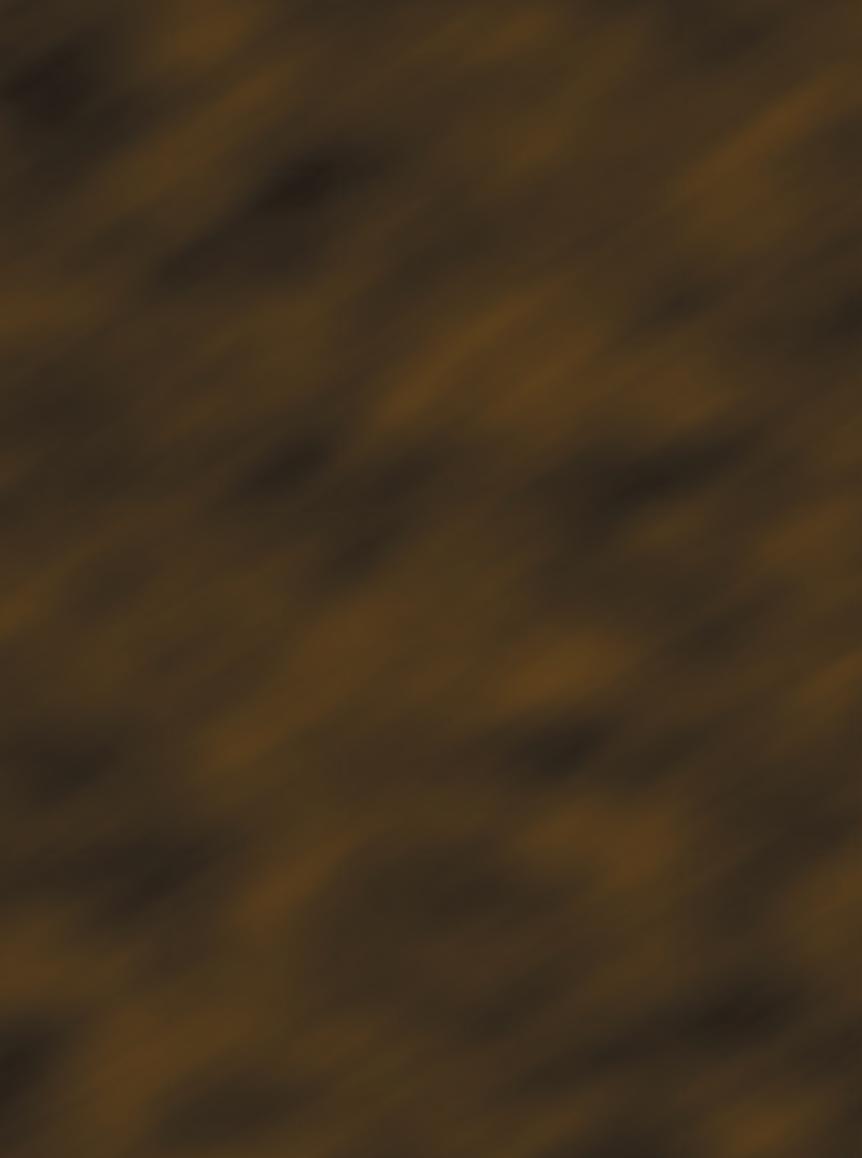
What are the main activities of your organisation? (Tick all that apply)
Constructionsof: Manufacturerof:
Roads/bridges Constructionequipment
Dams/reservoirs/irrigation Cement
Harbours/offshorestructures Otherconstructionmaterials
Foundations/tunnels Distribution Pipelines/reineries Construction equipment
Structures/steelwork Constructionmaterials
Building(commercial,industrial) Hire/rentalofconstructionequipment
Housing Design
Constructionmanagement Earth-moving/opencastmining Deepmining Aggregateproduction
Others(Pleasespecify)_________________________________________
Rate (Please tick)
RM264.00 -12issuesofJURUTERA
RM132.00 -6issuesofJURUTERA. Pleasespecifythesubscriptionmonth______________________________
RM74.00 -2issuesofJournal(half-yearly)
RM110.00 -AnnualIEMDirectory(Hardcopy)
RM75.00 -AnnualIEMDirectory(CD-ROM)
Terms and Conditions:
1) Thesubscriptionistobeprepaid.
2) Pleasemakechequepayableto Dimension Publishing Sdn Bhd.
3) Subscriptionsarenotrefundable.
4) Magazine/swillbesenttothemailingaddressgiven.
5) Studentsareentitledfora20%discountfromtheabovesubscriptionrate.
6) Students must submit a photocopy of the student identiication card together withthepayment.
7) Theaboverateisinclusiveofdeliverychargesandapplicablein Malaysiaonly.
8) Additionaldeliverychargeswillapplytooverseassubscribers.
For subscription enquiries, please contact +603-7493 1049 or email to subscription@dimensionpublishing.com

DIMENSIoN publIShINg SDN. bhD.
THE INSTITUTION OF ENGINEERS, MALAYSIA (IEM)
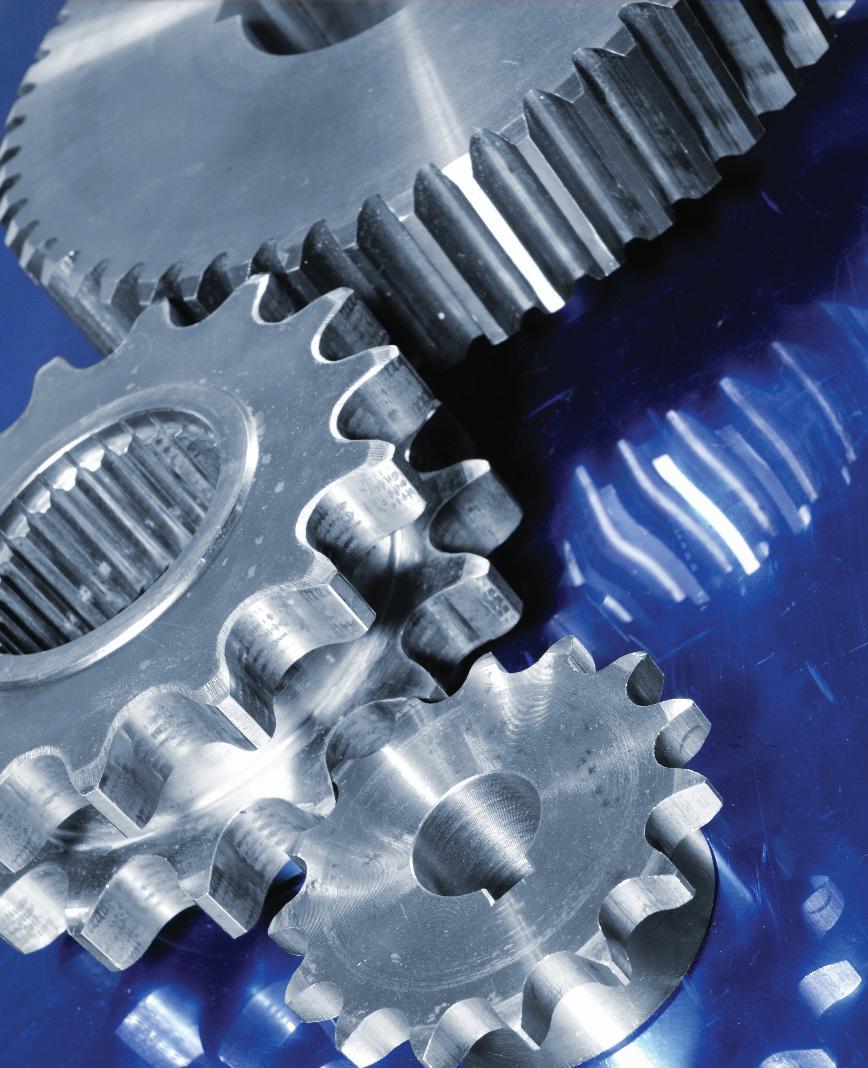
The oicial publisher of thE INStItutIoN of ENgINEERS, MalaySIa (IEM) – is proud to present the IEM DIREctoRy, which compiles criical businessdatafrombusinesspartners,andprovidesnaionwideexposure to key professionals in the engineering industry.
cIRculatIoN aND REaDERShIp pRofIlE
Our esteemed readership consists of ceriied engineers, decision making corporate leaders, CEOs, government oicials, project directors, entrepreneurs, project consultants, engineering consuling irms and companies involved with engineering products and services.
IEM DIRECTORY is circulated to more than 30,000 registered members of The Insituion of Engineers, Malaysia (IEM), with an esimated readership of 120,000 professionals.
aDVERtISINg bENEfItS
Our business partners can be assured that their products and services will be given the circulaion and exposure it deserves, thus maintaining a sustained adverising presence to our core readers of decisionmaking engineers and technical experts. Our website ofers an even wider market reach, with added internaional presence, aided by our internaional ailiaion with oicial engineering bodies all over the world. Our online and oline adverising features such as banner adverising, aricle sponsorship and direct e-mail announcements have proven to be successful markeing strategies that will set the businesses of our partners apart from their compeiion.
EDItoRIal coNtENtS
The IEM DIRECTORY is an excellent resource for businesses looking for engineering related products and services, business opportuniies and cooperaion with engineering irms, suppliers, distributors, consultants and qualiied professional engineers for major projects and business interests. Our content includes:
• Malaysia’s most comprehensive directory of engineering companies and consulting firms.
• Detailed descriptions of major and on-going projects.
• A decisive listing of companies providing goods and services to engineers and engineering businesses in a concise format, as well as an easily searchable index of companies sorted by engineering disciplines.
• A complete list of all current IEM Honorary Fellows, Fellows, Members, Graduate and Student Members.
• List of major Engineering related events, seminars and exhibitions in Malaysia.


DISplay aDVERtISINg RatES







